At the same time, the continued revival of Château Guiraud, under Canadian ownership, went on with a succession of fine vintages.
All of this appeared to culminate with the 1990, 1989, and 1988 vintages, which were considered to be the greatest Sauternes vintages since 1937, until 2001 emerged, a truly monumental vintage. Futures of these vintages became difficult to find, and a renewed confidence emerged. After all the difficulties they had experienced, the sweet wines of Barsac and Sauternes appeared poised to become fashionable once again on the world’s best tables.
While Mother Nature can be exceptionally kind to the region’s producers (1986–1990 for example), the period between 1991 and 1995 produced few inspirational wines from this area. At the time of writing, my tastings of the 2001s revealed magnificent wines, clearly the finest since 1990, 1989, and 1988. Modern-day technology has helped producers combat nature with a radical new winemaking procedure called cryo-extraction. This technique could be employed in less successful vintages to freeze the grapes and transform many so-so wines into something much richer and more interesting. Whether or not this will gain favor with the top estates, and whether or not it produces weaknesses in the wines when they are 10–25 years old, cannot be measured until well into the 21st century. But there is no question that it has helped raise the current quality of many wines.
No one doubts that the winemakers of Barsac and Sauternes face the most forbidding odds for producing successful wines. The hopes and fears regarding the outcome of a vintage normally begin at the time most of the red wine–producing appellations to the north have commenced or even finished their harvests. During the latter half of September, Mother Nature begins to unfold the climatic conditions that will be important for the vintages of this region. The climate in Barsac and Sauternes is normally misty, mild, and humid at this time of year. The foggy, damp mornings (created by the Ciron River that runs through the heart of Sauternes) and sunny, dry afternoons encourage the growth of a mold called Botrytis cinerea. This mold—commonly called “noble rot”—attacks each ripe, mature grape individually, devouring the grape skin and causing the grape to die and become dehydrated. Of course, only grapes that are attacked by noble botrytis rot are selected. Botrytis causes a profound change particularly in the Semillon grape. It shrivels the skin, consumes up to 50% of the sugar content, forms glycerol, and decomposes the tartaric acids. The result is a grape capable of rendering only one-fourth of its volume of juice prior to the botrytis attack—an unctuous, concentrated, aromatic, sweet nectar. Curiously, the reaction causes a super-concentration of the grape’s juice, which becomes considerably higher in sugar than normal. This happens without any loss of acidity.
This process is erratic and time-consuming. It can often take as long as one or two months for a significant portion of the white grapes to become infected by the botrytis mold. In some years very little botrytis develops, and the wines lack flavor dimension and complexity. When the noble rot does form, its growth can be painfully slow and uneven. Therefore, the great wines of this region can be made only by an arduous, time-consuming, labor-intensive process of sending teams of pickers into the vineyard to pick the afflicted grapes one at a time rather than bunch by bunch. The best estates have their pickers descend on the vineyard up to a half-dozen times over this period, which usually occurs throughout October and November, although some harvests have occurred in September. The famous Château d’Yquem often sends pickers through the vineyard ten separate times. As expensive and time-consuming as picking is, the most hazardous risk of all is the weather. Heavy rains, hailstorms, or frost—all common meteorological developments for Bordeaux in late fall—can instantly abort a promising vintage or turn it quickly into a disaster.
Since the conditions for making great wine are so different for Barsac and Sauternes, it is not surprising that what can be a great vintage for the red wines of Bordeaux can be challenging for the sweet white wines from this area. The years 2000, 1982, and 1961 are vintages in point. Undeniably profound years for the red wines, the sweet wines of Barsac and Sauternes had their problems. In contrast, 2001, 1988, 1980, 1967, and 1962 are five vintages for Barsac and Sauternes that most observers would consider very fine to superb. With the exception of 2001, 1988 and 1962, these vintages were less successful for most of the red wines of Bordeaux.
Like the red wines of the Médoc, the wines of Barsac and Sauternes were considered important enough to be classified into quality groupings in 1855. The hierarchy (see page 000) established Yquem as the best of the region, and it was called a “premier grand cru classé.” Following Yquem were “premiers crus classés” (now 11 as a result of several vineyards’ being partitioned), and 14 “deuxièmes crus classés” (now 12 because one has ceased to exist and two others have merged).
From a consumer’s perspective, three unclassified Cru Bourgeois estates, Raymond-Lafon, de Fargues, and Gilette, also make exquisite wines that rival many of the classified growths except for Yquem. However, they were not included in the 1855 classification. Additionally, there are a number of first growths and second growths that simply cannot afford to make wine the traditional way—using numerous crews of pickers working sporadically over a four- to eight-week period. Several do not merit their current status and have been downgraded in my evaluations of the châteaux of these regions.
As for Château d’Yquem, it towers (both literally and figuratively) above the other estates here, producing a splendidly rich, distinctive, unique wine. In my opinion, it is Bordeaux’s single most compelling wine. The official first growths of the Médoc have worthy challengers every year, often producing wine equally impressive, and the right bank trio of Cheval Blanc, Ausone, and Pétrus can in some vintages not only be matched, but surpassed by the brilliance of other estates in their respective appellations. Yquem, however, rarely has a challenger (except perhaps the elusive microscopic luxury cuvée of Coutet called Cuvée Madame). This is not because top Barsac and Sauternes properties such as Climens, Rieussec, or Suduiraut cannot produce superlative wine, but rather that Yquem produces a wine at such an extravagantly expensive level of quality that it is commercial madness for any other property even to attempt to emulate it.
When I wrote the first edition of Bordeaux in 1984, I was skeptical about the potential of all but a handful of the Barsac/Sauternes estates. Today the entire region has been transformed by the success of the 2001, 1990, 1989, 1988, and 1986 vintages and, for the most part, the estates are enjoying a degree of financial prosperity (perhaps even security) of which they would never have dreamed possible in the early 1980s. These wines, even with such revolutionary techniques as cryo-extraction, will always be among the most difficult in the world to produce, and a few bad vintages in a row or overreliance on new technology would no doubt dampen much of the appellation’s enthusiasm, but for now, optimism reigns supreme in what once was one of the most distressingly sad regions of Bordeaux.
BARSAC AND SAUTERNES
(An Insider’s View)
Overall Appellation Potential: Good to Superb
The Most Potential for Aging: Climens, Coutet Cuvée Madame, Gilette, Guiraud, Lafaurie-Peyraguey, Raymond-Lafon, Rieussec, Suduiraut, La Tour Blanche, Yquem
The Most Elegant: Climens, Coutet, Doisy-Daëne, Doisy-Védrines, Rieussec, La Tour Blanche
The Most Concentrated: D’Arche-Pugneau, Climens, Coutet Cuvée Madame, Lafaurie-Peyraguey, Raymond-Lafon, Rieussec, Suduiraut, Yquem
The Best Value: D’Arche-Pugneau, Bastor Lamontagne, Doisy-Daëne, Doisy-Védrines, Haut-Claverie, Les Justices, Rabaud-Promis, La Tour Blanche
The Most Exotic: D’Arche-Pugneau, Raymond-Lafon
The Most Difficult to Understand (when young): Until these wines are 4–6 years old, they rarely reveal much delineation or true personality
The Most Underrated: Rabaud-Promis, La Tour Blanche
The Most Difficult to Appreciate Young: All of them, at least until they are 4–6 years old
Up-and-Coming Estates: D’Arche-Pugneau, Rabaud-Promis, La Tour Blanche
Greatest Recent Vintages: 2001, 1990, 1989, 1988, 1986, 1983, 1976, 1975, 1967, 1962, 1959
BARSAC AND SAUTERNES—AN OVERVIEW
Location: Southeast of Bordeaux, about 26 miles from the center of the city
Acres Under Vine: 4,940; Sauternes—3,952; Barsac—998
Communes: Barsac, Bommes, Fargus, Preignac, and Sauternes
Average Annual Production: Sauternes—325,000 cases; Barsac—145,000 cases
Classified Growths: 26 classified growths and 1 premier cru supérieur—Château d’Yquem; 11 first growths, and 14 second growths
Principal Grape Varieties: Semillon and Sauvignon Blanc, with tiny quantities of Muscadelle
Principal Soil Type: Deep gravel beds over thick layers of limestone. In less desirable parts of the appellation, some sand and clay can be found.
A CONSUMER’S CLASSIFICATION OF THE CHÂTEAUX OF BARSAC AND SAUTERNES
OUTSTANDING
Climens, Coutet Cuvée Madame, Gilette, Rieussec, Suduiraut, Yquem3
EXCELLENT
D’Arche-Pugneau, Coutet, de Fargues, Guiraud, Lafaurie-Peyraguey, Raymond-Lafon, La Tour Blanche
VERY GOOD
Doisy Dubroca, Doisy-Védrines, Haut-Claverie, Rabaud-Promis, Sigalas Rabaud
GOOD
D’Arche, Bastor Lamontagne, Broustet, Clos Haut-Peyraguey, Doisy-Daëne, Filhot, Les Justices, Lamothe Guignard, Liot, de Malle, Nairac, de Rayne Vigneau, Romer du Hayot, Roumieu-Lacoste
OTHER NOTABLE PROPERTIES OF SAUTERNES AND BARSAC
Caillou, Lamothe, Lamourette, Piada, de Rolland, Saint-Marc, Suau
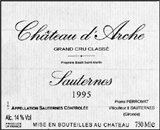
Classification: Second Growth in 1855
Owner: Société Themètre
Address: 33210 Sauternes
Telephone: 05 56 76 66 55; Telefax: 05 56 76 64 38
E-mail: chateau-arche@terrenet.fr
Website: www.chateaudarche.sauternes.com
Visits: Monday to Friday, 9 A.M.–12:30 P.M. and 1:30–4:30 P.M.
Contact: Sabine Cosson
VINEYARDS
Surface area: 66.7 acres
Grape varietals: 90% Semillon, 10% Sauvignon
Average age of vines: 45 years
Density of plantation: 7,000 vines per hectare
Average yields: 17 hectoliters per hectare
Elevage: Fermentation and 18–24 months aging in new oak barrels. Fining depending upon the vintage, filtration.
Château d’Arche: 35,000 bottles
Prieuré d’Arche: 15,000 bottles
Plateau of maturity: Within 5–15 years of the vintage
GENERAL APPRECIATION
A very reliable, reasonably priced wine that is impeccably well made.
Château d’Arche is another Sauternes that began producing better and better wine during the 1980s. Given the quality of the wines, their prices are among the most reasonable of the appellation. The style of wine produced at d’Arche offers very unctuous, rich fruit, no doubt because of the high percentage of Semillon, but also because of the late harvesting and the proprietor’s serious commitment (there are normally 7–10 passes through the vineyard to pick only those grapes affected by botrytis).
IMPORTANT VINTAGES
2001 |
Honeysuckle, grapefruit, and citrus are present in this medium to full-bodied, very fresh, well-delineated wine. Relatively deep, concentrated, with good acidity, it should drink well for two decades. Anticipated maturity: now–2018. Last tasted, 3/01. |
2000 |
Not a great deal of complexity, but plenty of glycerin, fat, and moderate sweetness characterize this somewhat monolithic wine that has some hints of pineapple and other tropical fruit. Drink it over the next decade. Last tasted, 1/03. |
1997 |
This is an estate where the 1997 possesses more botrytis, complexity, potential ripeness, and longevity than the 1996. The 1997 d’Arche is an excellent, elegant, medium- to full-bodied Sauternes with noteworthy smoky, pineapple, and orange notes. Ripe and creamy-textured with moderate sweetness, this cleanly made wine should evolve nicely for 10–12+ years. Last tasted, 3/01. |
1996 |
The lighter-styled, well-delineated, fruit-driven 1996 is simple and straight-forward, with medium sweetness. Anticipated maturity: now–2010. Last tasted, 3/01. |
1990 |
The 1990 d’Arche may be overripe and too alcoholic. It is quite powerful, but its lack of acidity may prove to be its undoing. If the wine pulls itself together, it will turn out to be a good to very good, muscular Sauternes that will offer big, thick, chewy fruit in a high alcohol, fiery format. Hopefully, it will evolve for another decade. Last tasted, 11/94. |
1989 |
The 1989, which seemed heavy-handed and out of focus in both barrel and bottle, appears to have come together (a hopeful sign for the 1990), displaying straightforward, ripe, chewy, muscular fruit in a low-acid, moderately sweet style. It should drink well for 7–8 years. Last tasted, 11/94. |
1988 |
This is a beautifully made, intense wine with a gorgeous nose of honeyed pine-apple fruit. In the mouth, it is unctuous and full-bodied, with great sweetness and presence and a long, rich, nearly viscous finish. It is very forward for the vintage. Anticipated maturity: now. Last tasted, 4/91. |
1986 |
This is another highly successful vintage for d’Arche. Not so rich or thick as the 1988, but more classy from an aromatic point of view, this full-bodied, concentrated wine exhibits telltale flavors of honeyed oranges and pineapples and even the smell of coconut. The finish is long and crisp, with a great deal of botrytis in evidence. Anticipated maturity: now–2006. Last tasted, 3/90. |
D’Arche made a very good 1983 and a less interesting 1982 and 1981. I also have notes on a surprisingly good 1969. I think it can be safely said that the efforts of the former proprietor, Pierre Perromat, who took over the running of the property in 1981, have resulted in far greater wines in the 1980s than in previous decades. That progression continues under the new owners.
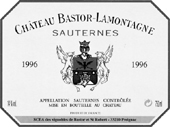
Classification: None
Owner: Foncier Vignobles
Address: 33210 Preignac
Telephone: 05 56 63 27 66; Telefax: 05 56 76 87 03
E-mail: bastor-lamontagne@dial.oleane.com
Website: www.atinternet.fr/bastor-lamontagne
Visits: By appointment Monday to Friday, 8 A.M.–noon and 2:30–6 P.M.
Contact: Michel Garat
VINEYARDS
Surface area: 138.3 acres
Grape varietals: 80% Semillon, 20% Sauvignon
Average age of vines: 37 years
Density of plantation: 7,000 vines per hectare
Average yields: 20 hectoliters per hectare
Elevage: Fermentation in barrels (80% of yield) and vats. Thirteen to eighteen months aging in barrels with 15% new oak. No fining, filtration.
WINES PRODUCED
Château Bastor Lamontagne: 60,000–70,000 bottles
Les Remparts de Bastor: 30,000–50,000 bottles
Plateau of maturity: Within 3–15 years of the vintage
GENERAL APPRECIATION
A very fruity style of wine that tends to be agreeable at a young age.
Bastor Lamontagne has always been a personal favorite of mine, particularly when I am looking for a reasonably priced Sauternes to buy as an alternative to some of the more glamorous (as well as more expensive) names. The property, located in Preignac, near the great estate of Suduiraut, has, to my knowledge, never made bad wines. Everything I have tasted from the mid-1970s onward has been made in an intelligent, ripe, rich, velvety style filled with opulent, pure fruit. These are not woody Sauternes since very little new oak (only 20%) is used. Rather they are luscious, amply endowed, sweet wines for drinking in their first 10–15 years of life.
As the following tasting notes attest, Bastor Lamontagne, while never outstanding, is consistently very fine. In fact, the great value is the realistic price and steady quality from vintage to vintage.
IMPORTANT VINTAGES
1997 |
Excellent tropical fruit (primarily pineapples) intermixed with scents of lanolin are attractive in this medium-to full-bodied, fresh, concentrated wine. Good underlying acidity nicely buttresses the wine’s weighty feel in the mouth. An excellent lower-level Sauternes, it should drink well during its first two decades of life. Anticipated maturity: now–2020. Last tasted, 3/01. |
1996 |
Compared to the 1997, the 1996 is made in a lighter style with less fat, as well as the telltale apricot/pineapple and lanolin characteristics of Semillon (which dominate the blend). Medium-bodied and refreshing, this mid-weight Sauternes is easily appreciated. Anticipated maturity: now–2012. Last tasted, 3/01. |
1989 |
Very typical of the vintage, the 1989 Bastor Lamontagne is extremely low in acidity and ripe, with surprisingly evolved medium-gold color and a great deal of fruit and coarseness that I have rarely seen in other vintages of this wine. It will no doubt have to be drunk quite early. Anticipated maturity: now. Last tasted, 4/91. |
1988 |
This is an excellent wine, with abundant quantities of botrytis, as evidenced by its honeyed pineapple-and-orange-scented nose. In the mouth, it is full, wonderfully pure, focused, and long, with moderate sweetness. This Sauternes could actually serve as a good apéritif as well as a dessert wine. Anticipated maturity: now. Last tasted, 4/91. |
1986 |
Another excellent example of Bastor Lamontagne, the 1986 offers an enthralling nose of caramel, oranges, and spices intermixed with scents of flowers. Full-bodied and luscious, with a lot of alcohol and glycerin, as well as evidence of botrytis, this honeyed wine is already drinking beautifully. Anticipated maturity: now. Last tasted, 3/89. |
1983 |
A voluptuous, luscious wine with oodles of ripe, botrytised pineapple fruit, medium- to full-bodied texture, and a long, rich, silky finish all combine to titillate the palate. This Bastor Lamontagne is precocious, but so tasty. Anticipated maturity: now. Last tasted, 3/88. |
1982 |
Bastor Lamontagne made a shockingly good wine in 1982. It is a lovely, richly fruity, moderately sweet, well-balanced Sauternes with plenty of character. The wine is forward and ready. Anticipated maturity: now. Last tasted, 1/85. |
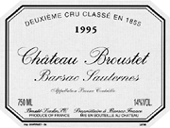
Classification: Second Growth in 1855
Owner: Didier Laulan
Address: 33720 Barsac
Telephone: 05 56 27 16 87; Telefax: 05 56 27 05 93
Visits: By appointment only
Contact: Didier Laulan
VINEYARDS
Surface area: 39.5 acres
Grape varietals: 63% Semillon, 25% Sauvignon, 12% Muscadelle
Average age of vines: 35 years
Density of plantation: 6,600 vines per hectare
Average yields: 15 hectoliters per hectare
Elevage: Twenty to twenty-five day fermentations in small temperature-controlled stainless-steel tanks of 25–50 hectoliter capacity. Wines are aged in oak barrels (20% new oak) for the first year and in stainless-steel vats for the second. They are fined and filtered.
WINES PRODUCED
Château Brouster: 20,000 bottles
6 Château de Séqur: 5–10,000 bottles
Plateau of maturity: Within 5–20 years of the vintage
GENERAL APPRECIATION
This is a solid but somewhat dull style of wine that ages well, but is rarely exciting.
Broustet is one of the rarely encountered and least-known Barsacs, largely because the production is so small. The property was in the Fournier family between 1885 and 1992, when it was sold to Didier Laulan.
Many improvements have been made at Broustet since the mid-1980s. While the wine is still fermented in stainless-steel tanks, the percentage of new oak barrels has been increased to 50%, and the château has introduced a second wine for weaker vats. They have also added a dry white wine to their portfolio.
IMPORTANT VINTAGES
1997 |
The diluted, light-bodied, undistinguished 1997 Broustet offers fruit-cocktail notes in the nose, light to moderate sweetness, medium body, and a clean finish. It should drink well young, and keep for eight more years. Anticipated maturity: now–2011. Last tasted, 3/01. |
1996 |
This is another monolithic example, with more fruit, elegance, and potential complexity than the 1997. It is straightforward and foursquare, with some botrytis and honeyed orange and pineapple fruit. Drink it over the next 10–12 years. Last tasted, 3/01. |
1989 |
The 1989 should be consumed in its first decade of life because it already offers a big, fat, plump, juicy mouthful of wine. Surprisingly elegant for a 1989, but still extremely alcoholic and not that complex, it is a sweeter wine than the 1988 but lacks the flavor dimension and character of the previous vintage. Anticipated maturity: now. Last tasted, 4/91. |
1988 |
The 1988 has the advantage of having more acidity, additional complexity, and an uplifting bouquet of honeyed apricot/peach fruit, which, along with its vibrancy, gives its powerful, rich, intense flavors a sense of balance and focus. It is the best Broustet I have ever tasted. Anticipated maturity: now–2008. Last tasted, 4/91. |
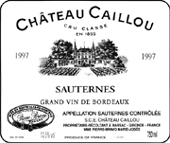
Classification: Second Growth in 1855
Owner: Michel and Marie-Josée Pierre
Address: 33720 Barsac
Telephone: 05 56 27 16 38; Telefax: 05 56 27 09 60
E-mail: chateaucaillou@aol.com
Website: www.chateaucaillou.fr
Visits: By appointment only
Contact: Michel or Marie-Josée Pierre
VINEYARDS
Surface area: 32.1 acres
Grape varietals: 90% Semillon, 10% Sauvignon
Average age of vines: 35–40 years
Density of plantation: 6,600 vines per hectare
Average yields: 15 hectoliters per hectare
Elevage: Twenty-one to twenty-eight day fermentation in vats. Sixteen to twenty months aging in barrels with 33% new oak. Fining and filtration.
WINES PRODUCED
Château Caillou: 8,000–10,000 bottles
Les Erables du Caillou: 11,000–12,000 bottles
Plateau of maturity: Within 5–10 years of the vintage
GENERAL APPRECIATION
An elegant, fruity, reliable wine, Caillou is never a leader, but then again, it is never expensive.
This is a relatively obscure Barsac property located on route D118 to the east of Barsac. The vineyard’s soil is limestone and clay. The château’s twin towers dominate the modest two-and-a-half-story building and are easily seen from the road.
The reputation of Caillou’s wines has been mixed, although many critics have claimed Caillou has been largely ignored as a competent producer of lighter-styled Barsacs. Fermentation takes place in temperature-controlled, stainless-steel tanks, after which the wine is filtered before it goes into small barrels, of which 20% are new each year. I have never been that impressed with the wines of Caillou, although a 1947 I tasted in 1987 was in good shape. Recently, there does appear to have been significant improvement, as the 1990, 1989, and 1988 all tasted more serious and complex than their predecessors.
IMPORTANT VINTAGES
1997 |
The 1997 Caillou possesses low acidity, an unctuous texture, plenty of honeyed tropical fruit, medium to full body, and a cloying, fat, extremely sweet style. It needs to firm up and exhibit more focus. It will last for 10–12 years. Last tasted, 3/01. |
The 1996 is a foursquare, fruit-driven, clean, medium-bodied wine with a moderately sweet finish. Anticipated maturity: now–2012. Last tasted, 3/01. |
|
1990 |
Caillou tends to produce compact, richly fruity, moderately sweet wines that rarely have the complexity found in the better Barsac/Sauterness estates. The 1990 displays a honeyed, ripe cherry/apricot/orange-scented nose, surprisingly good acidity, and a medium to full-bodied, thick, chewy finish. About as impressive as Caillou can be, it will last for 10–15 years. Last tasted, 11/94. |
1989 |
The 1989 is a fat, sweet, chunky wine without much complexity or delineation. I liked previous examples more, but the wine’s low acidity is causing it to taste more diffuse as it ages. Last tasted, 11/94. |
1988 |
The 1988 is thick, ripe, and rich, with attractive honeyed pineapple-like fruitiness, medium to full body, and a more elegant personality than its two siblings. It should drink well for another decade. Last tasted, 11/94. |
1986 |
This is an unexciting, even insipid wine that lacks depth and finishes with a short, attenuated feel. It is hard to understand what went wrong in this excellent vintage. Anticipated maturity: now. Last tasted, 3/90. |
1985 |
Light-intensity flavors of pineapples and oranges are attractive in a low-key way. In the mouth, the wine is off dry, medium-bodied, and relatively light, with no evidence of botrytis. Anticipated maturity: now. Last tasted, 3/90. |
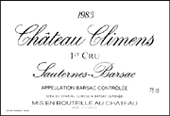
Classification: First Growth in 1855
Owner: Bérénice Lurton
Address: 33720 Barsac
Telephone: 05 56 27 15 33; Telefax: 05 56 27 21 04
E-mail: contact@chateau-climens.fr
Website: www.chateau-climens.fr
Visits: By appointment Monday to Friday, 9 A.M.–5 P.M.
Contact: Bérénice Lurton
VINEYARDS
Surface area: 76.6 acres
Grape varietals: 100% Semillon
Average age of vines: 35 years
Density of plantation: 6,300 vines per hectare
Average yields: 13 hectoliters per hectare
Elevage: Fermentation and 18–24 months aging in barrels with 30–50% new oak. No fining, filtration.
WINES PRODUCED
Château Climens: 30,000 bottles
Cyprès de Climens: 15,000 bottles
Plateau of maturity: Within 7–25 years of the vintage
One of France’s monumental sweet wines, Climens is a personal favorite. It combines great nobility with laser-like flavor precision. A tour de force in winemaking.
The most famous estate of the Barsac/Sauternes region is, without question, Château d’Yquem, which makes the most concentrated and expensive sweet white wine in France. But the wine I find most companionable with food, and most complex and compelling to drink, is that of Château Climens in Barsac. Climens has been owned since 1971 by the Lurton family, who presides over a considerable empire of Bordeaux estates, including the famous Margaux properties of Châteaux Brane Cantenac, Durfort-Vivens, and Desmirail. All of these properties produce good wine, but none of them has quite the standing in its respective commune that Château Climens has in Barsac.
For much of the last two centuries, Climens has been considered one of the two leading estates in the commune of Barsac. The 72-acre vineyard and modest one-story château (the only physical distinctions are two slate-roofed towers at each end) is located just north of the tiny village of La Pinesse, sitting on the highest plateau of the Barsac region, a full 70 feet above sea level. Most observers claim that this elevation has contributed to the vineyard’s excellent drainage, giving Climens a distinct advantage over lower-lying properties in wet years.
While the names of most châteaux here can be traced back to former owners, no one is quite sure how Climens acquired its name. For most of the 19th century the château was owned by the Lacoste family, who produced a wine they called Château Climenz-Lacoste. At that time the vineyard’s 70 acres achieved an annual production of 6,000 cases, but the devastating effects of phylloxera in the late 19th century destroyed most of the vineyards in Bordeaux, including those of Climens. In 1871 Climens was sold to Alfred Ribet, the owner of another estate called Château Pexoto, which was subsequently absorbed into what is today known as Château Sigalas Rabaud.
In 1885 Ribet sold the property to Henri Gounouilhou, whose family managed Climens until the current proprietor, the dynamic Lucien Lurton, purchased it in 1971. It was Henri Gounouilhou, director of Bordeaux’s most famous daily newspaper, Sud-Ouest, and his successors who raised not only the level of quality at Climens, but also the public’s awareness of this great estate. The legendary vintages of 1947, 1937, and 1929 enabled Climens to surpass the reputation of its larger neighbor, Château Coutet, and rival even that of the great Château d’Yquem.
The Lurtons, Brigitte and Bérénice, have merely enhanced the extraordinary reputation of this outstanding property. Their only change has been the removal of the small quantities of Muscadelle planted in the gravel, red sand, and clay-like soil of the vineyard. The current plantings, which they believe produce the best wine from the terroir of Château Climens, are 100% Semillon. The Lurtons eschew Sauvignon in the blend because it has a tendency to lose its aroma after several years. The average age of the vines is maintained at an impressive 35 years, as the Lurtons believe in replanting only 3–4% of the vineyard per year. In addition, their yield of 16 hectoliters per hectare remains one of the smallest of all the estates in the Sauternes/Barsac region. (Today, when most major wine-producing estates are doubling the yields from their vineyards, Climens commendably maintains an average annual production of only 3,333 cases, from a vineyard area 1.6 acres larger than it was in the mid-19th century.) No doubt this statistic alone accounts for the exceptional concentration and quality of the wine produced.
The wine is fermented in cask and aged for 12–18 months in 55-gallon barrels before being bottled. In most vintages, 33% new oak is used; this is believed to develop the proper marriage of honeyed pineapple-and-apricot-flavored fruit with the vanilla toastiness of new oak barrels.
What makes Climens so precious is that it produces the region’s most compellingly elegant wine. There is no doubt that for sheer power, viscosity, and opulence, Climens will never rival Château d’Yquem, nor even Château Rieussec, Château Suduiraut, and the luxurious, rare Cuvée Madame of Château Coutet. However, if one measures the greatness of a wine by its extraordinary balance and finesse, Climens not only has no peers, it deserves the reputation as the most quintessentially graceful wine of the region. Many Sauternes can border on the cloying, but in the top vintages Climens seems to combine a rich, luscious, exotic character of honeyed pineapple fruit with a remarkable inner core of lemony acidity—giving the wine zestiness, precision to its flavors, and a profound, hauntingly pleasurable bouquet.
Consistently one of the most profound wines of Barsac/Sauternes, this wine, made from 100% Semillon, is one of the most ravishing examples of just how much elegance can be built into a powerful racehorse style of wine.
IMPORTANT VINTAGES
ANCIENT VINTAGES
Climens has a brilliant record, surpassed only by Yquem for consistency and the number of great wines that were produced. In the 1970s, the 1976 (90 points; last tasted 11/00), 1975 (91 points; last tasted 3/99), and 1971 (96 points; last tasted 8/02) are all great wines. Even the museum piece vintages can be stunning, including the 1962 (90 points; last tasted 3/97), 1949 (96 points; last tasted 1/01), 1947 (94 points; last tasted 11/90), 1937 (90 points; last tasted 11/88), and 1929 (92 points; last tasted 11/88). I suspect pristinely stored bottles of all these wines would still be in terrific condition.
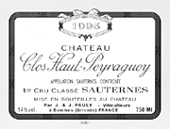
Classification: First Growth in 1855
Owner: GFA du Clos Haut-Peyraguey
Address: 33210 Bommes
Telephone: 05 56 76 61 53; Telefax: 05 56 76 69 65
E-mail: j.j.pauly@worldonline.fr
Visits: Every day of the week, by appointment for groups
Contact: Martine Langlais-Pauly
Surface area: 42 acres
Grape varietals: 90% Semillon, 10% Sauvignon
Average age of vines: 35 years
Density of plantation: 6,600 vines per hectare
Average yields: 16 hectoliters per hectare
Elevage: Fermentation in barrels with 50% new oak. Twenty-four months aging with 35% new oak. Fining, no filtration.
WINES PRODUCED
Château Clos Haut-Peyraguey: 24,000 bottles
Château Haut-Bommes: 12,000 bottles
Plateau of maturity: Within 5–12 years following the vintage
GENERAL APPRECIATION
This is an estate that is clearly improving in quality. Prices remain fair.
In the 1855 classification there was only one premier cru classé, Château Peyraguey, but in 1879 the property was divided. The smaller parcel became known as Clos Haut-Peyraguey. For much of the early 1980s, 1970s, and 1960s, the quality of the wines was indifferent. However, improvements have been made in the 1990s and late 1980s.
IMPORTANT VINTAGES
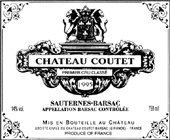
Classification: First Growth in 1855
Owner: Château Coutet, SC, Philippe and Dominique Baly
Address: 33720 Barsac
Telephone: 05 56 27 15 46; Telefax: 05 56 27 02 20
E-mail: chateaucoutet@aol.com
Website: www.chateau-coutet.fr
Visits: By appointment only
Contact: Danièle Constantin
VINEYARDS
Surface area: 93.9 acres
Grape varietals: 75% Semillon, 23% Sauvignon, 2% Muscadelle
Average age of vines: 35 years
Density of plantation: 5,600 vines per hectare
Average yields: 13 hectoliters per hectare
Elevage: Fermentation and 16–18 months aging in new oak barrels. Fining and filtration.
WINES PRODUCED
Château Coutet: 30,000–50,000 bottles
Chartreuse de Coutet: 15,000–20,000 bottles
Plateau of maturity: Within 5–25 years of the vintage
COUTET CUVÉE MADAME
This special cuvée is produced only in great vintages. The grapes usually come from a special parcel of 2–2.5 ha (35 years of age), and are picked one by one, when they are considered extremely mature and of homogeneous concentration. They are usually picked in one passage. Fermentations last three to six weeks in 100% new oak barrels, and wines are aged 24 months. Wines are fined and filtered upon bottling. Quantities produced are very small. (The blend is the same as for Château Coutet.)
GENERAL APPRECIATION
One of the classics of the region, Coutet is a model of elegance and balanced sweetness.
Coutet has always been one of the leading as well as one of the largest estates of Barsac. Famous for an elegant, less sweet, and less powerful wine, Coutet is usually well made, stylish, and probably a more flexible wine to serve with a variety of food dishes than many of the intense, super-concentrated, lavishly oaked wines that this region produces in abundance.
Coutet does produce a tiny amount of incredibly rich, unctuous wine that is rarely ever seen commercially but is worth mentioning because it is one of this region’s two finest wines (the other, of course, being Yquem). In certain vintages Coutet produces a special cuvée called Cuvée Madame. Between 1997 and 1943 it was produced only in 1990, 1989, 1988, 1986, 1981, 1975, 1971, 1959, 1950, 1949, and 1943. Rumors were afloat that a 2001 would emerge. Approximately 1,200 bottles—or just four barrels—of this wine are made, and should you ever see any, do not hesitate to try it, because the Cuvée Madame of Coutet is pure nectar. The 1989, 1988, 1986, 1981, and 1971 vintages of Cuvée Madame, along with the 1921 Yquem, represent the greatest sweet wines from this region that I have ever tasted.
As for the regular cuvée of Coutet, the vintages produced immediately after Marcel Baly purchased the property in 1977 appeared light and indifferent, but since 1983 Coutet has been making top-notch wines nearly every vintage. In fact, this appears to be a property that is deadly serious about challenging Climens’s historical role as the top estate in the Barsac region.
Coutet also produces a dry wine that is very fresh, attractively priced, and best drunk when it is 4–5 years old.
IMPORTANT VINTAGES
2001 |
One of the great Coutets I have tasted, with amazing definition, extraordinary vibrancy and force, and sweet, thick, juicy flavors of tropical fruits, peach, honeysuckle, and buttered popcorn, this glorious Barsac looks to be set for an incredibly long life. Anticipated maturity: 2007–2025. Last tasted, 1/03. |
2000 |
Somewhat one-dimensional and simple, as are many 2000s, but with loads of fruit and moderate sweetness, this wine should be drunk over the next decade. Last tasted, 1/03. |
1999 |
A big, lively, fruit-dominated wine, with hints of vanilla, mineral, pineapple, and peach, this medium-bodied wine shows good spice, zingy acidity, and plenty of structure. It is an elegant, understated, moderately sweet style that should evolve quickly. Anticipated maturity: now–2015. Last tasted, 1/03. |
1998 |
This exquisite combination of elegance and finesse offers up notes of tropical fruits, particularly pineapple and some mandarin oranges, along with the telltale citrus and honeysuckle. It is medium to full-bodied, with good sweetness and terrific purity. Drink it over the next 10–15 years. Last tasted, 3/01. |
1997 |
Another classic example of elegance allied to richness and intensity, Coutet’s 1997 exhibits an expressive, floral, citrusy, honeyed nose, with notes of orange, Chinese black tea, pineapple, and spicy oak. It is all finesse, with honey, medium to full body, gorgeous delineation, and refreshing underlying acidity. It should drink well young. Anticipated maturity: now–2020. Last tasted, 3/01. |
1996 |
A cooler, lighter-bodied wine than the 1997 with a greenish hue to its light-gold color, this ripe, medium-bodied Barsac reveals toasty notes along with fresh, citrusy tropical fruit, some sweetness, and a clean, pure finish. It is a good all-purpose Barsac to drink as an aperitif, with food, or after dinner with dessert. Anticipated maturity: now–2018. Last tasted, 3/00. |
The full-bodied 1990 is sweet, rich, and honeyed, but it lacks the clarity and complexity of the 1989. Last tasted, 11/94. |
|
1990 |
Cuvée Madame: Medium green/gold–colored, the 1990 is aging at a glacial pace. It offers a profound bouquet of smoky, toasty new oak combined with honeyed peaches and apricots, as well as coconuts and a touch of crème brûlée. With extraordinarily rich, full-bodied, marvelously extracted personalities, as well as wonderful underlying acidity, it is a spectacular wine. Anticipated maturity: now–2035. Last tasted, 2/03. |
1989 |
This was one of the few wines where the 1989 was the superior offering. The richest, sweetest, and fattest, it offers a pure nose of pineapples, full body, and excellent concentration. Anticipated maturity: now–2015. Last tasted, 3/96. |
1989 |
Cuvée Madame: Deep, bright gold in color, this blockbuster sweet wine offers up aromas of coffee, custard, toastiness, honeyed tropical fruits, and a coconut note. Unctuously textured and oozing glycerin, extract, and richness, this full-bodied yet extraordinarily well-delineated wine offers the rare combination of power and complexity. It is an amazingly thick Cuvée Madame that suffers only in comparison with its surrounding siblings. Anticipated maturity: now–2030. Last tasted, 11/94. |
1988 |
The lighter-bodied, drier 1988 is less weighty than the 1990 and 1989, with attractive, spicy, vanilla, citrus scents, medium body, and an earthy note that kept my score from going higher. Anticipated maturity: now–2018. Last tasted, 11/94. |
1988 |
Cuvée Madame: Cut from the same mold as other Cuvée Madames, but perhaps the ultimate example because the intense botrytis and unctuousness the wine possesses is buttressed by slightly more acidity, giving the wine all the weight and massiveness of its two younger siblings, the 1990 and 1989, but with more focus and vibrancy. It is difficult for readers who have never tasted Cuvée Madame to imagine a wine of such honeyed richness, power, and flavor dimension not tasting heavy. The 1988 is still young, even more youthful than the 1990 and 1989, with good underlying acidity and luxuriantly rich layers of viscous, full-bodied flavors of crème brûlée, peaches, apricots, and pears. The finish lasts for over 40 seconds. This may turn out to be the most compelling of all the profound Cuvée Madames that have been made to date. Anticipated maturity: now–2035. Last tasted, 11/94. |
1986 |
This is a fine example of Coutet, quite precocious, with an evolved bouquet of tropical fruit, honey, and spring flowers. It is full-bodied and rich, with crisp acidity and plenty of evidence of botrytis in its apricot/peach-like flavors. The finish is heady and long, with just enough acidity for balance. Anticipated maturity: now–2005. Last tasted, 11/91. |
1986 |
Cuvée Madame: This unbelievably decadent, unctuous wine has the type of extract (but without the overlay of heavy, toasty oak) that one normally finds only in a great vintage of Yquem. The wine is much less evolved than the regular cuvée of Coutet. At the moment, it is crammed with honeyed tropical fruit that comes across in a powerful format. This is an enormously rich, almost overwhelmingly intense Barsac that needs another decade to begin to reveal its subtleties and complexities. It is mind-blowing! Anticipated maturity: now–2020. Last tasted, 3/97. |
1985 |
The problem with so many 1985 Barsac/Sauternes is that they come across as monolithic and one-dimensional, particularly when compared with years where there is a great deal more botrytis, such as 1988 and 1986. Nevertheless, for those readers who like to drink these wines as an apéritif, 1985 is the type of vintage where the wines can be drunk early in the meal. The 1985 is fresh, with plenty of fruit, but is lacking the complexity one normally associates with this château. Anticipated maturity: now. Last tasted, 3/90. |
Not the biggest, most concentrated, or most luscious Coutet, this wine gets high marks because of undeniable elegance, breed, class, and a fresh, lively feel on the palate. The flavors reveal excellent ripeness, and the wine’s refreshing crispness makes this an exceptionally enjoyable, non-cloying Barsac. Anticipated maturity: now–2005. Last tasted, 3/89. |
|
1981 |
Surprisingly mature and ready to drink, the 1981 Coutet is an agreeable wine but lacks richness and complexity. What it does offer is straightforward, fruity, lemony, melon aromas and moderately sweet, somewhat short flavors. Drink up. Anticipated maturity: now. Last tasted, 6/84. |
1981 |
Cuvée Madame: This is a medium-golden wine with a huge honeyed aroma filled with the scents of oranges, toast, coconuts, and other tropical fruits. Thick, unctuous flavors coat the palate. There is just enough acidity to provide lift and focus. This is a colossal wine. Anticipated maturity: now–2008. Last tasted, 12/90. |
1971 |
Cuvée Madame: Wines such as this are almost impossible to describe effectively. Spectacular from the first time I tasted it in the mid-1970s, I have been fortunate enough to have had this wine three more times. Each bottle has been better than the last, suggesting that perhaps more magical things may emerge. There is an extraordinary fragrance of spring flowers, honeyed fruits, herbs, and vanilla, and a strong scent of crème brûlée. In the mouth, there is remarkable richness and super-acidity that give the wines clarity and lift. Gobs of botrytis are obvious, and the richness and extract levels are amazing. The color has changed little since I first tasted it. I would predict at least another 10–20 years of longevity. This is one wine to go out of your way to taste. Anticipated maturity: now–2005. Last tasted, 3/88. |
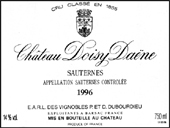
Classification: Second Growth in 1855
Owners: Pierre and Denis Dubourdieu
Address: 33720 Barsac
Telephone: 05 56 27 15 84; Telefax: 05 56 27 18 99
Website: Under construction
Visits: By appointment only
Contact: Denis Dubourdieu (Telephone: 05 56 62 96 51; Telefax: 05 56 62 14 89; E-mail: reynon@gofornet.com)
VINEYARDS
Surface area: 37 acres
Grape varietals: 80% Semillon, 20% Sauvignon
Average age of vines: 35 years
Density of plantation: 7,100 vines per hectare
Average yields: 18–20 hectoliters per hectare
Elevage: Fermentation and 18–24 months aging in barrels that are renewed by a third at each vintage. Fining and filtration.
WINES PRODUCED
Château Doisy-Daëne: 36,000–40,000 bottles
No second wine is produced.
Plateau of maturity: Within 3–12 years following the vintage
Note: This estate also produces some 30,000 bottles of a 100% Sauvignon dry white Château Doisy-Daëne (fermentation and 10–15 months aging on lees in barrels that are renewed by quarter at each vintage). In some vintages, (2001, 1997, 1996, and 1990), the special cuvée l’Extravagance de Doisy-Daëne is produced. Availabilities are limited (4–5 barrels); hence, the wine is commercialized in 375 ml. bottles.
GENERAL APPRECIATION
This is a meticulously made wine with the emphasis on early drinkability as well as oodles of honey-drenched tropical fruit. In short, it is a wine certain to win a popularity contest.
One of the most ambitiously and innovatively run estates in Bordeaux, Doisy-Daëne produces a very fine Barsac that seems to be undervalued in the scheme of Barsac/Sauternes realities. While I would not rate it a premier cru classé, it is certainly one of the leaders among the deuxièmes crus classés. The proprietors of Doisy-Daëne, Pierre and Denis Dubourdieu, also produce one of the finest dry wines of the region, Doisy-Daëne Sec, a full and refreshing, vibrant, fruity, and—best of all—very inexpensive white wine. Pierre’s son, Denis, a professor at the Institute of Oenology in Bordeaux, more than anyone else has totally revolutionized the making of white wine in the Bordeaux region with his classic macération pelliculaire (skin contact and very cool fermentation temperatures). The objective is to produce wines that retain their remarkable fruit and freshness and to reduce the amount of sulphur used in the winemaking process to negligible quantities.
Doisy-Daëne’s sweet wine is surprisingly enjoyable when young, causing many tasters to think that it will not last. Although the style today is certainly different from when the 1959 and 1924 were made, I remember drinking both of those wines in 1984 when they were still fresh, lively, and full of fruit. Doisy-Daëne remains one of the more fairly priced sweet wines of the Barsac/Sauternes region. For those who want to drink their sweet wines on the younger side, this is a property of which to take note.
Note on l’Extravagance de Doisy-Daëne: This small cuvée of 50–125 cases has been made only in 2001 (100% Sauvignon Blanc), 1997 (100% Semillon), 1996 (100% Sauvignon), and 1990.
IMPORTANT VINTAGES
2001 |
A greenish light-gold color is followed by a richly fruity wine with loads of peach, pear, honey, and vanilla notes, an elegant, medium-bodied palate, good acidity, and plenty of botrytis. The wine is not one of the sweetest of the 2001s, but no doubt very flexible with food. Anticipated maturity: 2004–2015. Last tasted, 1/03. |
2001 |
L’Extravagance de Doisy-Daëne: This is a huge, big, unctuous fruit bomb, but one with botrytis, honeysuckle, and all the great things that make these wines so compelling. Is this wine significantly better than some of the other vintages of this limited 125-case cuvée? I am not sure, but this is a multidimensional, textured, massive wine with medium-gold color and great botrytis, yet, at the same time, good acidity. Anticipated maturity: 2010–2040. Last tasted, 1/03. |
2000 |
Honeyed pineapple is the dominant aroma and flavor of this light gold–colored wine. It shows good ripeness, plenty of fruit, and a somewhat unctuous texture. Anticipated maturity: now–2011. Last tasted, 1/03. |
This is a straightforward wine with a deep medium-gold color and ripe honeyed botrytis flavors, with some caramel and abundant exotic fruits such as pineapple and passion. The wine almost has a lychee nut characteristic as well. Drink it over the next 10–20 years. Last tasted, 12/02. |
|
1998 |
Medium to full-bodied, with a moderately gold color showing some underlying green tints, this wine has good acidity, sweet attack, medium to full body, and a long, somewhat one-dimensional, but pure finish. It should drink well for 10–15 years. Last tasted, 12/02. |
1997 |
The impressive 1997 regular bottling offers a moderately intense nose of coconuts intermixed with smoke, cherries, and honeyed lemons and pineapples. There is outstanding purity, gorgeous fruit, seemingly low acidity, and an excellent fat, fleshy finish. This wine may merit an outstanding score if it develops more complexity. Anticipated maturity: 2005–2015 Last tasted, 3/01. |
1997 |
L’Extravagance de Doisy-Daëne: In total contrast to the 1996 L’Extravagance, which was 100% Sauvignon Blanc, the 1997 is 100% Semillon. It has a huge amount of residual sugar in a very sweet, unctuous/viscous style, with gobs of noble rot, plenty of buttered, honeyed fruits, still-reticent aromatics, but phenomenal intensity and mass on the palate. It does not quite seem to have the finesse of the 1996, but it is certainly a thicker, richer wine that hits all sensory receptors on the palate and in the olfactory senses. Anticipated maturity: now–2020. Last tasted, 11/02. |
1996 |
The 1996 is a stylish, mineral-laden, moderately sweet wine with mid-weight, honeyed complexity, and a fresh, lively finish. Drink it over the next 8–10 years. Last tasted, 3/01. |
1996 |
L’Extravagance de Doisy-Daëne: The 1996 has a light-gold color, an unctuous texture, and a gorgeous nose of caramel, buttered pineapple, coconut, and crème brûlée, followed by enormously concentrated, dense flavors that, in spite of their mass and richness, are not at all heavy given the surprising acidity. This wine should have 30 or more years of aging potential. Anticipated maturity: 2010–2035. Interestingly, the 1996 L’Extravagance is 100% botrytised Sauvignon Blanc. Last tasted, 11/02. |
1990 |
The 1990 regular cuvée is revealing far more complexity and richness than it did in the past. It is a bold, opulent, exquisite example of Barsac, with more richness and intensity than I have encountered in previous vintages of Doisy-Daëne. Light- to medium-gold colored, with a honeyed, botrytised nose, huge amounts of alcohol and power, and a heady finish, the wine possesses just enough acidity to balance out its bold flavors and forcefulness. Drink it over the next 15+ years. Last tasted, 11/94. |
1990 |
L’Extravagance de Doisy-Daëne: The 1990 possesses considerable botrytis, awesome extract levels and intensity, and, despite massive power, remarkable balance. Readers are unlikely to find any of this wine (bottled in a heavy 375 ml. bottle) outside Bordeaux. Its medium-gold color and extraordinary richness and power suggest it will age effortlessly for another 20+ years. Last tasted, 11/94. |
1989 |
The 1989 exhibits plenty of honeyed ripe fruit, a more elegant personality, fine richness, chunkiness, and depth, full body, and low acidity. It does not reveal the botrytis found in the 1990 or 1988. Last tasted, 11/94. |
1988 |
The 1988 is the lightest of these wines, with medium body and a fragrant pineapple, peach, and apple-scented nose, with a honeysuckle component that adds complexity. The wine is crisp, dry, and ideal for drinking now and over the next 10 years. Last tasted, 11/94. |
1986 |
While less viscous and chewy than the 1983, this is still an admirably rich, husky, intense Barsac with vividly pure, well-focused fruit, full body, and a long, honeyed finish. Anticipated maturity: now–2005. Last tasted, 3/90. |
I could find no evidence of botrytis in this wine, which comes across as relatively fat, uncomplex, and straightforward. Anticipated maturity: now. Last tasted, 3/90. |
|
1983 |
Doisy-Daëne finished its harvest one month after Yquem and has possibly produced this property’s finest wine in over two decades. A big, ripe bouquet of pineapples, peaches, and spring flowers is very attractive. On the palate, the wine is concentrated, full-bodied, and unctuous, without being too heavy or alcoholic. Excellent acidity suggests a long, eventful evolution. Anticipated maturity: now–2005. Last tasted, 3/90. |
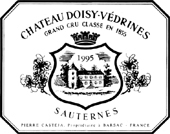
Classification: Second Growth in 1855
Owner: Castéja family
Address: 33720 Barsac
Mailing address: 33720 Barsac
Telephone: 05 56 68 59 70; Telefax: 05 56 78 37 08
Visits: By appointment only
Contact: Olivier Castéja
VINEYARDS
Surface area: 66.7 acres
Grape varietals: 80% Semillon, 15% Sauvignon, 5% Muscadelle
Average age of vines: 30 years
Density of plantation: 6,500 vines per hectare
Average yields: 17 hectoliters per hectare
Elevage: Fermentation and 18 months aging in oak barrels with 60% new oak. Fining, filtration if required.
WINES PRODUCED
Château Doisy-Védrines: 60,000 bottles
Generic Sauternes: 30,000 bottles
Plateau of maturity: Within 4–16 years of the vintage
GENERAL APPRECIATION
Always rich in fruit, but sometimes too blatantly obvious, Doisy-Védrines is normally a good value.
This Barsac estate is well placed just to the southeast of the two most famous Barsacs, Climens and Coutet. Unfortunately, the tiny production of sweet Doisy-Védrines prevents many wine enthusiasts from ever discovering how good this wine can be. Most wine drinkers are probably better acquainted with the dry white and red table wine produced at this estate. It is called Chevalier de Védrines and is a delightful commercial wine that is equally good in either white or red. As for the sweet wine, Doisy-Védrines is much fatter, richer, and more intense than the wine of next-door neighbor Doisy-Daëne. Doisy-Védrines is a wine that is usually at its best 5–7 years after the vintage but will age considerably longer, particularly in the top vintages.
The estate is run by the well-known Castéja family that also controls the négociant firm Roger Joanne. Doisy-Védrines has been in the Castéja family since 1840. Castéja is one of the few Barsac producers who is quick to declassify any vintage they deem to be of unsatisfactory quality. For example, no wine was produced under the Doisy-Védrines label in 1974, 1968, 1965, 1964, or 1963.
IMPORTANT VINTAGES
2001 |
Light gold with a gorgeous nose of tropical fruit, caramel, spice, and honey, this wine is rich, intense, and full-bodied, with good acidity and loads of fruit and flesh. It is moderately sweet. Anticipated maturity: 2006–2016. Last tasted, 1/03. |
2000 |
Honeyed apricots and white corn emerge from this light golden–colored wine. The wine has plenty of fruit and seems a bit simple compared to its younger sibling, the 2001. Anticipated maturity: now–2012. Last tasted, 1/03. |
1999 |
This is a rather high-toned, crisp, medium-weight style of Sauternes with a pale straw/gold color and notes of underripe peaches and apricots intermixed with grapefruit and other citrus. The wine is medium bodied and moderately sweet, with very good acidity. Drink it over the next 10–12 years. Last tasted, 3/01. |
1990 |
Although somewhat monolithically styled, there is no doubting the 1990’s unctuously textured, thick, sweet style. The color is light-medium gold. The wine offers plenty of honeyed citrus fruit in addition to smoke and vanilla. Medium to full-bodied, with good acidity, some evidence of botrytis, and a plump, low-acid finish, this heavyweight, chunky wine should age nicely for 15–20 years. Anticipated maturity: now–2015. Last tasted, 3/97. |
1989 |
Medium-gold colored, with botrytis, crème brûlée, and honeyed tropical fruits in the nose, this full-bodied, sweet wine possesses good acidity, layers of glycerin-imbued, plump, chewy, honeyed fruit, and plenty of spice and alcohol in the lusty finish. It is a luxuriously made, in-your-face style of sweet wine. Anticipated maturity: now–2012. Last tasted, 3/97. |
1988 |
A youthful-tasting (the youngest when compared to the bigger, thicker 1990 and 1989 wine) the 1988 is made in a more elegant style, with smoky, crème brûlée, and honeyed citrus and pineapple notes in the aromatics and flavors, medium to full body, moderate sweetness, zesty acidity, and a fine finish. This promising, youthful wine possesses 20 more years of longevity. Anticipated maturity: now–2018. Last tasted, 3/97. |
1986 |
Doisy-Védrines made a superb wine in 1986. It is powerful, complex, and nearly as mouth-filling as their great 1989. It does have crisper acidity and, for the moment, a more complex, floral, honeyed bouquet. There is no denying the unctuous, huge, tropical fruit flavors. Anticipated maturity: now–2005. Last tasted, 11/90. |
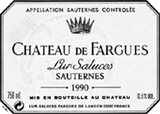
Owner: Alexandre de Lur Saluces
Address: 33210 Fargues de Langon
Telephone: 05 57 98 04 20; Telefax: 05 57 98 04 21
E-mail: fargues@chateau-de-fargues.com
Website: www.chateau-de-fargues.com
Visits: By appointment Monday to Friday, 9 A.M. to noon and 2–5 P.M.
Contact: François Amirault
VINEYARDS
Surface area: 37 acres (34.6 in production)
Grape varietals: 80% Semillon, 20% Sauvignon
Average age of vines: 35 years
Density of plantation: 6,600 vines per hectare
Average yields: 12 hectoliters per hectare
Elevage: Fermentation and 36 months aging in new oak barrels. Fining, no filtration.
WINES PRODUCED
Château de Fargues: 15,000 bottles
No second wine is produced.
Plateau of maturity: Within 8 to 25 years of the vintage
Note: This estate also produces a dry white Bordeaux called Guilhem de Fargues in certain vintages (2000, 1999, 1996, 1994, and 1993). The production is around 3,600 bottles.
GENERAL APPRECIATION
The small production guarantees rarity. Additionally, shrewd consumers looking for a wine similar to Yquem at a fraction of the price keep most bottles of this wine from ever hitting a retailer’s shelf.
In 1472, 300 years before the Lur Saluces family acquired the famous Château d’Yquem, they owned Château de Fargues. While de Fargues has never been classified, the quality of the wine produced is brilliant. Still owned by the Lur Saluces family, it receives virtually the identical winemaking care that Yquem does. In some vintages, de Fargues has often been the second-best wine produced in the Sauternes region, and when it is tasted blind, many tasters, including most experts, usually judge it to be Yquem. In all fairness, the wine lacks the aging potential of Yquem, but when young, the resemblance can be extraordinary.
Interestingly, the vineyard of de Fargues is located well to the east of Yquem’s, and the harvest occurs on an average of 10 days later. Additionally, the yield is less than at Yquem, causing some to say that if Yquem’s tiny yield per vine equals only one glass of wine, the yield of a vine at de Fargues must equal only two-thirds of a glass of wine.
De Fargues’s similarity to Yquem is uncanny, and given the price charged for de Fargues—approximately one-third that paid for a bottle of Yquem—it is irrefutably a bargain. Unfortunately, the production of de Fargues is tiny, thereby reducing the opportunity for many wine enthusiasts to taste this wine (which some, by the way, jokingly call Yquem, Jr.).
IMPORTANT VINTAGES
1990 |
Medium-deep gold with a complex, perfumed bouquet of caramel, tea, pineapple, and crème brûlée, this is an atypically powerful de Fargues with massive body as well as an unctuous finish. Anticipated maturity: 2005–2020. Last tasted, 12/02. |
Light-golden colored with a green hue, the 1988’s smoky nose offers up scents of tobacco, wood, honeysuckle, peaches, and orange skins. Medium to full-bodied and elegant, with moderate sweetness, good acidity, and loads of finesse, this is a restrained wine that builds incrementally in the mouth. Anticipated maturity: 2004–2020. Last tasted, 12/02. |
|
1986 |
The toasty, honeyed, rich bouquet is redolent of pineapples, coconut, crème brûlée, and coffee. In the mouth, this fabulously rich, full-bodied wine offers plenty of the botrytised, pineapple, and other tropical fruit flavors, a lavish, unctuous texture, enough acidity to provide freshness and focus, and a heady, spicy, truly intoxicating finish. Anticipated maturity: now–2010. Last tasted, 3/90. |
1985 |
This is a big, corpulent, chunky wine without much botrytis, but plenty of flesh and a muscular, heady alcohol content. The wine drinks beautifully now because of the forward, lush fruit married with copious amounts of smoky, toasty new oak. The good acidity gives the wine freshness. While I am sure this wine will evolve nicely, I do not expect ever to encounter a great deal of complexity. Anticipated maturity: now. Last tasted, 3/90. |
1983 |
While no match for the extraordinary wine produced at Yquem in this vintage, the 1983 de Fargues (aged three years in 100% new oak casks) is, nevertheless, a sensational example of a Sauternes with an amazing resemblance to Yquem. A big, buttery, caramel, smoky, crème brûlée, and honeyed pineapple nose is enthralling. In the mouth, the wine is powerful, very sweet, rich, extremely full, and framed beautifully by toasty new oak. Quite full-bodied and intense, this large-scaled wine should have a great future. Anticipated maturity: now–2008. Last tasted, 3/90. |
1981 |
This wine has improved significantly and actually tastes better than the 1981 Yquem—as hard as that may be to believe. Spectacularly rich, very sweet, and alcoholic, it has taken on a medium-gold color. There is plenty of evidence of botrytis, but the low acidity and unctuous, thick, viscous feel on the palate suggest this is a wine probably best drunk over the next decade. Anticipated maturity: now. Last tasted, 3/90. |
1980 |
A great vintage for de Fargues, the 1980 from this estate is very powerful, opulent, and exotic. The bouquet of coconuts, apricots, grilled almonds, and spicy oak is sensational. In the mouth, the wine is decadently rich, full-bodied, and remarkably similar in taste, texture, and viscosity to Yquem. Retasted twice in 1989 with equally enthusiastic notes. Anticipated maturity: now. Last tasted, 3/89. |
1979 |
Less powerful and rich than normal, the 1979 de Fargues is light golden, with a toasty, lemony, fruity, oaky bouquet, medium to full body, some botrytis, good acidity, and a clean, spicy, rich, alcoholic finish. Anticipated maturity: now. Last tasted, 3/86. |
1976 |
A full-blown crème brûlée aroma intermingled with scents of caramel and apricots is penetrating. Full-bodied, with viscous, sweet, ripe flavors of tropical fruit and smoked nuts, this big, robust, yet surprisingly mature wine remains fully mature but displays no signs of declining. Anticipated maturity: now–2005. Last tasted, 2/91. |
1975 |
The 1975 is one of the finest de Fargues ever produced. It has the Yquem-like bouquet of coconuts, grilled nuts, ripe exotic fruit, and spicy oak. On the palate, the 1975 is more tightly structured and less evolved than the 1976. It has a lighter golden color and more acidity, but every bit as much concentration and richness. Anticipated maturity: now–2010. Last tasted, 2/91. |
1971 |
Incredibly rich, unctuous, fat, spicy, and chewy, this huge wine offers oodles of coconut, apricot, and almond flavors, yet viscous fruitiness, huge body, and a head-spinning alcohol content. Fully mature, this is a big, old-style, intense Sauternes. Anticipated maturity: now. Last tasted, 12/80. |
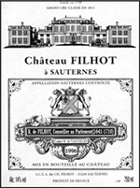
Classification: Second Growth in 1855
Owner: GFA Château Filhot—de Vaucelles family
Address: 33210 Sauternes
Telephone: 05 56 76 61 09; Telefax: 05 56 76 67 91
E-mail: filhot@filhot.com
Visits: By appointment only
Contact: Henri de Vaucelles, Gabriel de Vaucelles
VINEYARDS
Surface area: 153.1 acres
Grape varietals: 60% Semillon, 36% Sauvignon, 4% Muscadelle
Average age of vines: 37 years
Density of plantation: 6,000 vines per hectare
Average yields: 13–14 hectoliters per hectare
Elevage: Ten to thirty day fermentation in temperature-controlled stainless-steel vats. Twenty-four to thirty-six months aging by rotation in barrels (renewed by a third at each vintage) and in vats. No fining, light filtration upon bottling.
WINES PRODUCED
Château Filhot: up to 100,000 bottles
Château Sauternes and Château Pineau du Rey: up to 60,000 bottles
Plateau of maturity: Within 4–12 years of the vintage
GENERAL APPRECIATION
A lighter styled, very refreshing wine that rarely has the weight of the appellations blockbusters, but increasingly well made, and fairly priced.
Filhot, one of the most magnificent estates in the entire Sauternes region, possesses an 18th-century manor home beautifully situated among ancient trees that has the look of an Ivy League college campus. This property has the potential to produce extraordinary wines, particularly given this superb location just to the north of the village of Sauternes on gravelly hillside beds with a southwest orientation. However, it has been only since the mid-1980s that Filhot has begun to produce wines that merit its deuxième cru classé status.
Because of the relatively high percentage of Sauvignon and the utilization of only one-third new oak, Filhot tastes fruitier, more aromatic, and lighter than some of the larger-scaled Sauternes wines. That fact does not, however, account for the lack of consistency and the numerous indifferent and mediocre efforts that were turned out by Filhot during the early 1980s, 1970s, and 1960s. Yet quality clearly appeared to rebound in the late 1980s.
2001 |
Pineapple, citrus, sealing wax, and spice are in the aromatics and flavor of this finesse-styled, moderately sweet Sauternes/Barsac. The wine is elegant, with lively purity, medium body, and a reasonably long finish. Anticipated maturity: now–2012. Last tasted, 1/03. |
2000 |
Light greenish-gold in color, this medium-bodied wine exhibits straightforward pear, pineapple, and peach flavors and a moderate sweetness. However, it is a bit simple and one-dimensional. Drink it over the next 7–8 years. Last tasted, 1/03. |
1996 |
An elegant, medium-bodied wine with scents of quince, orange marmalade, and pineapple presented in a moderately endowed aromatic profile, this Sauternes displays moderate sweetness, excellent ripeness and purity, and a tasty, harmonious personality. Drink it over the next 10–12 years. Last tasted, 3/02. |
1990 |
Filhot, which prefers to tank rather than barrel ferment its wines, produced a 1990 that is clearly the best wine I have tasted from this estate. It exhibits gorgeously ripe, honeyed tropical fruit, an intense, medium- to full-bodied personality, wonderful purity, fine acidity, plenty of botrytis, and a long, zesty finish. What makes this wine so appealing is its combination of richness, crisp acidity, liveliness, and zestiness. Anticipated maturity: now–2007. Last tasted, 11/94. |
1989 |
The thick, very sweet, slightly heavy 1989 appears to be maturing at a fast pace. If drunk over the next 5–8 years it will provide an uncomplicated mouthful of sweet, candied fruit. Anticipated maturity: now. Last tasted, 11/94. |
1988 |
The 1988 displayed a wonderfully pure, honeyed pineapple-scented nose, rich, medium- to full-bodied flavors, fine underlying acidity, an earthiness that added to the wine’s complexity, and a clean, rich, crisp finish. Drinkable now, it should continue to evolve gracefully for 10–15 years. Last tasted, 11/94. |
1986 |
The 1986 is the best Filhot in my memory. The light golden color is followed by a wine with a floral, pineapple, and tropical fruit bouquet, medium body, as well as lovely, elegant, and brilliantly pure, botrytised, lively flavors. Just medium sweet, this wine could be served as an apéritif wine. Anticipated maturity: now. Last tasted, 3/90. |
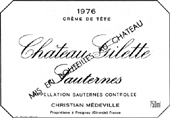
Classification: Cru Bourgeois
Owner: Christian Médeville
Address: 33210 Preignac
Mailing address: BP 14, 33210 Preignac
Telephone: 05 56 76 28 44; Telefax: 05 56 76 28 43
E-mail: christian.medeville@wanadoo.fr
Visits: By appointment Monday to Thursday, 9 A.M.–noon and 2–5 P.M.; Friday, 9 A.M.–noon and 2–3 P.M.
Contact: Julie Gonet-Médeville
VINEYARDS
Surface area: 11.1 acres
Grape varietals: 90% Semillon, 9% Sauvignon, 1% Muscadelle
Average age of vines: 45 years
Density of plantation: 6,600 vines per hectare
Average yields: 9 hectoliters per hectare
Elevage: Fermentation and 15 months aging in temperature-controlled stainless-steel vats. No fining, filtration.
WINES PRODUCED
Château Gilette: 5,000 bottles
No second wine is produced.
Plateau of maturity: Within 20–40 years of the vintage
GENERAL APPRECIATION
An anomaly because of the practice of not releasing wine for 15–25 years, Gilette has a special place because of its high quality and remarkable longevity.
Gilette is one of the most unusually run properties in the Sauternes region. It is one of the finest-made wines in Sauternes despite the fact that Gilette was not classified. The vineyard, situated several miles north of Yquem, adjacent to route D109, is planted on sandy soil with a subsoil of rock and clay. However, what is bizarre and unbelievable in today’s harsh world of commercial realities is that Gilette’s proprietor, Christian Médeville, holds his sweet wines for over 20 years in concrete vats prior to bottling them. For example, he bottled the 1955 in 1984, 29 years after the vintage. The fact that his wines are excellent and have a honeyed maturity has caused some of France’s leading restauranteurs (like Pierre Troisgros) to beat a path to his door to purchase his old vintages of Sauternes.
Gilette’s late-released wines, called “Crème de Tête,” are extremely well balanced, remarkably well-preserved wines, with plenty of viscous, fruity flavors and deep amber/golden colors. After being held in vats for decades, the wines often taste much younger when they are released than their vintage date would suggest. If my instincts are correct, most vintages of Gilette can benefit from another 15–25 years of cellaring after being released. The following are some of the vintages of Gilette that have been released for sale by M. Médeville over the last decade.
IMPORTANT VINTAGES
1979 |
Crème de Tête: A medium-gold color is followed by a buttery, earthy perfume revealing hints of tropical fruits and crème brûlée. This medium-bodied 1979 displays surprising youthfulness (a characteristic of Gilette), good acidity, and a long, sweet finish. While not a blockbuster example, it is a noteworthy effort in what was a good rather than great vintage for Sauternes. Anticipated maturity: now–2012. Last tasted, 12/02. |
1978 |
Crème de Tête: A terrific example from this vintage, Gilette’s 1978 Crème de Tête exhibits a deep gold color in addition to a sweet nose of honeysuckle intermixed with baked pears, pineapples, vanilla beans, and crème brûlée. Full-bodied and opulent, with tremendous levels of botrytis as well as extracted flavors, crisp acidity, and surprising power and intensity, it will be drinkable between now and 2012. Last tasted, 12/02. |
Crème de Tête: A stunning example of this vintage, Gilette’s 1975, released in 1997, exhibits a deep-gold color, followed by a spicy vanilla-scented nose with loads of fresh, lively, honeyed citrus, buttery pineapple/pear–like fruit. The wine is probably sweeter than it tastes, but because of the good acidity, it comes across as an off-dry, dazzlingly rich, full-bodied, exceptionally fresh Sauternes with razor-sharp definition and a finish that lasts for more than 30 seconds. It is stunningly youthful, as well as complex and marvelous. Anticipated maturity: now–2010. Last tasted, 3/97. |
|
1971 |
Crème de Tête: This is a more reserved, austere, restrained wine, with a tight but attractive nose of loamy earth, roasted coffee, herbs, and sweet, honeyed fruit. Medium to full-bodied, with tightly wound flavors, good acidity, and moderate levels of botrytis, this is a less generous yet stylish, polite Gilette that should continue to age well for 15 or more years. Last tasted, 3/97. |
1970 |
Crème de Tête: The 1970 has a deep, rich-golden color and a big, spicy bouquet of buttery, apricot-scented fruit; it’s full-bodied and amazingly fresh and youthful for its age, and will probably keep another 15–25 years. It lacks the complexity of the great vintages of Gilette but, nevertheless, is an impressively full, complex wine. Anticipated maturity: now-2005. Last tasted, 3/90. |
1967 |
Crème de Tête: Everyone agrees that no greater wine was made in 1967 than Château d’Yquem, but I would love to have the opportunity to taste Gilette’s 1967 Crème de Tête alongside Yquem. This fabulously rich wine has an awesomely intense bouquet of caramel and buttery hazelnuts, combined with intense aromas of honeyed fruit such as pineapples, oranges, and apricots. Decadently rich, with an unctuous, chewy texture, yet with enough acidity to provide great delineation and balance, this is a magnificent wine that has miraculously retained an amazing freshness for its 23 years of age. It should continue to evolve and improve for another 30, perhaps even 40, years. This is an outrageous thrill-a-sip Sauternes! Anticipated maturity: now–2025. Last tasted, 3/90. |
1962 |
Crème de Tête: The 1962 offers a very complex, honeyed nose filled with decadent apricot and peach scents that can come from heavily botrytised fruit. Very full-bodied, with good acidity and opulent, rich crème brûlée flavors, this luscious, full-throttle Sauternes should continue to drink well for at least another 15–20 years. Anticipated maturity: now–2015. Last tasted, 3/90. |
1961 |
Crème de Tête: I have never tasted a great 1961 Sauternes, although I am sure this region’s wines benefited immensely from the great reputation of the reds in this vintage. However, the white wines were nowhere near the quality of either the 1962s or 1959s. Most have turned out to be very good, relatively dry, old white wines with a great deal of alcohol but not much charm or fat. Gilette’s 1961 is very fine, although significantly less rich and opulent than the 1962. It is almost dry. It could be the perfect partner with a rich dish that contained foie gras as one of the primary ingredients. Anticipated maturity: now–2001. Last tasted, 3/90. |
1959 |
Crème de Tête: This is a decadent, honey pot of a wine. It is medium-deep golden, with a huge bouquet of smoked nuts, coffee, mocha, coconut, and decadently jammy apricot and peach-like fruit. In the mouth, the wine has astonishing richness, super-glycerin content, a great deal of body, and a long, alcoholic, smashingly intense, heady finish. Seemingly fully mature, yet still remarkably fresh and young, this wine can easily last for another 20 or more years. Anticipated maturity: now–2010. Last tasted, 3/90. |
1955 |
Crème de Tête: Fully mature, but still astonishingly fresh and alive, the 1955 Gilette is deep golden in color, with a rich, honeyed bouquet, full body, and a ripe, long finish. It can probably last another 10–15 years. Anticipated maturity: now–2005. Last tasted, 11/90. |
Crème de Tête: Slightly less rich and fat than the 1955, the 1953 is spicy and oaky, with a bouquet suggesting melted caramel and ripe pineapples. Full-bodied, still fresh and lively, this unctuous, rich wine is quite impressive. Anticipated maturity: now. Last tasted, 11/90. |
|
1950 |
Quite fat and sweet, with excellent ripeness, full body, and a long, deep, velvety finish, this wine is a revelation given its age. This is a big, heavyweight Sauternes that will last for 15–20 more years. Anticipated maturity: now–2005. Last tasted, 1/85. |
Classification: First Growth in 1855
Owner: SA du Château Guiraud
Address: 33210 Sauternes
Mailing address: BP 1, 33210 Sauternes
Telephone: 05 56 76 61 01; Telefax: 05 56 76 67 52
E-mail: xplanty@club.internet.fr
Website: www.chateau.guiraud.fr
Visits: By appointment only
Contact: Noëlle Eymery or Mrs. Amirault
VINEYARDS
Surface area: 210 acres
Grape varietals: 65% Semillon, 35% Sauvignon
Average age of vines: 25 years
Density of plantation: 6,600 vines per hectare
Average yields: 12 hectoliters per hectare
Elevage: Fermentation and 30 months aging in new oak barrels. Fining and filtration.
WINES PRODUCED
Château Guiraud: 9,600 bottles
Le Dauphin du Château Guiraud: 30,000 bottles
Plateau of maturity: Within 5–20 years of the vintage
GENERAL APPRECIATION
This superb estate is on top of its game, thanks to the brilliant administrator, Xavier Planty. A delicious dry white wine called “G” is also made at Château Guiraud.
Guiraud is one of the largest estates of the Sauternes district, covering almost 300 acres, of which 210 are planted with vines. Curiously, the estate produces a red wine with the Bordeaux Supérieur appellation and a dry white wine called “G.”
The sweet wine of Guiraud has undergone a metamorphosis. In 1981 an ambitious Canadian, Hamilton Narby, purchased the estate and made bold promises that Yquem-like techniques of individual grape picking, barrel fermentation, and long aging in new oak barrels would be employed at Guiraud. Consequently, Bordeaux wine enthusiasts, particularly the nectar lovers, have taken great interest in the goings-on at Guiraud in the hopes that his administrator, Xavier Planty, has the talent to bring Narby’s dreams to fruition.
The most surprising thing about Guiraud is that the wine is so rich given the high percentage of Sauvignon Blanc (35%) used in the blend. No doubt the use of new oak, late picking, and numerous passes through the vineyard ensure that only the ripest Sauvignon Blanc is harvested. But I am still perplexed as to why this wine is so intense despite that Sauvignon Blanc. Vintages since 1983 have been especially strong, and Guiraud is often one of the top half-dozen wines now being made in the Barsac/Sauternes region.
IMPORTANT VINTAGES
2001 |
A gorgeous example of Guiraud, the honeysuckle, butterscotch, toasty new oak aromas interplay with ripe tropical fruits and sautéed butter in a complex, full-throttle bouquet. Quite powerful, dense, full-bodied, beautifully delineated, with loads of botrytis, this is an impressive, backward yet tremendously promising wine. Anticipated maturity: 2008–2025. Last tasted, 1/03. |
2000 |
A very sweet, medium-golden style, with caramelized pineapples intermixed with some vanilla and crème caramel, this wine is full-bodied, with luscious fruit, but lacks complexity, which typifies so many of the 2000 Barsac/Sauternes. Anticipated maturity: now–2015. Last tasted, 1/03. |
1999 |
A very vibrant style of wine from Guiraud, with less sweetness than usual, some what monolithic, with relatively high acidity, 9,000 cases were produced of this medium gold–colored wine. It is quite tight, shows some botrytis, hints of coconut, pineapple, and crème brûlée, medium body, and a firm finish. Anticipated maturity: 2005–2018. Last tasted, 12/02. |
1998 |
One of the vintage’s most successful wines, the 1998 Guiraud (55% Semillon and 35% Sauvignon with a huge production of 12,000 cases) is very low in acidity, extremely intense, with loads of botrytis, noteworthy honeysuckle, jammy, pineapple and tropical fruit notes, along with some espresso and caramel. There is good freshness, but this is a Guiraud to drink during its first 15 or so years of life. Last tasted, 12/02. |
1997 |
Medium gold, with a hint of green, this wine has somewhat foursquare notes of honeyed, canned lychee nuts intermixed with orange marmalade, butter, and sautéed hazelnuts. The wine is full-bodied, thick, very fat, and seems destined to show more aromatics and delineation as it evolves in the bottle. The 1997 is a blend of 65% Semillon and 35% Sauvignon Blanc. Anticipated maturity: now–2020. Last tasted, 11/02. |
1996 |
A very deep, evolved, golden color, this wine shows brandied tangerine and orange blossom notes with hints of buttered white corn, caramel, crème brûlée, and roasted nuts. The wine is relatively complex, quite rich, and full-bodied, and it seems to be on a relatively quick evolutionary track. Anticipated maturity: now–2016. Last tasted, 11/02. |
1990 |
In the past, I preferred the 1988 Guiraud, followed by the 1989, and, last, the 1990. In recent tastings the 1990 has taken first prize with its showy display of power, highly extracted, smoky, buttery, pineapple and orange-scented fruit, lavish quantities of toasty new oak, and unctuously thick, massive flavors and texture. This huge wine avoids being overbearing because of its adequate acidity. It should evolve well for 15–20 more years. Last tasted, 11/94. |
The 1989 is extremely disjointed. Although big and rich, it tastes like a glob of sugar, alcohol, and wood. This was a disappointing showing for the 1989. It should gain focus and return to the form predicted for it when it was in barrel. Last tasted, 11/94. |
|
1988 |
More tight and backward than I remembered it, the 1988 exhibits a stylish, spicy nose of ripe fruit, some botrytis, medium- to full-bodied flavors with well-integrated oak, an attractive, smoky, honeyed fruit character, and a lively finish. It is more shy and reticent than usual. It should last for 20–30 years. Last tasted, 5/98. |
1986 |
Wealthy collectors will have a great deal of fun comparing the 1989, 1988, and 1986 as they evolve over the years. The 1986 was the finest Guiraud made up to that point, although I suspect the 1988 will last longer and have higher acidity and better overall balance. However, the 1986 is a super-concentrated, aromatic wine with gobs of botrytis and creamy, unctuous, peach, pineapple, and apricot flavors. There is plenty of new oak to frame the wine, although the overall acidity is less than in the 1988. The finish is exceptionally long and well balanced. This is a massive, concentrated wine that should easily develop over several decades. Anticipated maturity: now–2009. Last tasted, 3/90. |
1985 |
Guiraud has turned out a well-made 1985, with a great deal of sweetness, plenty of ripeness, and obvious aromas of toasty, smoky new oak. There is no botrytis in evidence, and the wine exhibits less finesse and complexity than vintages such as 1986 and 1983. Nevertheless, this straightforward style of Sauternes will have its admirers, particularly among those who like to drink these wines as an apéritif. Anticipated maturity: now. Last tasted, 3/90. |
1983 |
Light golden, with a ripe, intense bouquet of apricots and pineapples, as well as the vanilla scents from having been aged in cask, this full-bodied, lush, rich wine has excellent concentration, superb balance, and a zesty, long, alcoholic finish. Anticipated maturity: now–2005. Last tasted, 3/90. |
Classification: First Growth in 1855
Owner: Groupe Suez
Address: Peyraguey, 33210 Bommes
Mailing address: 160, cours du Médoc, 33300 Bordeaux
Telephone: 05 57 19 57 77; Telefax: 05 56 95 53 01
Visits: By appointment only
Contact: Yannick Laporte (Telephone: 05 56 76 60 54; Telefax: 05 56 76 61 82)
VINEYARDS
Surface area: 101.3 acres
Grape varietals: 90% Semillon, 8% Sauvignon, 2% Muscadelle
Average age of vines: 40 years
Density of plantation: 6,666 vines per hectare
Average yields: 18 hectoliters per hectare
Elevage: Fermentation and 18–20 months aging in barrels that are renewed by a third each year. Fining and filtration.
WINES PRODUCED
Château Lafaurie-Peyraguey
La Chapelle de Lafaurie-Peyraguey
Plateau of maturity: Within 5–25 years of the vintage
GENERAL APPRECIATION
This is consistently one of the finest wines of Sauternes, always made in a full-throttle style.
Long in the doldrums, Lafaurie-Peyraguey has emerged in the 1980s as one of the great producers of decadently rich, complex, and compelling Sauternes wines. The decision to reduce the percentage of Sauvignon in the wine, to increase the amount of new oak, and to institute a stricter selection began to result in a string of highly successful Sauternes starting with 1981 and culminating with the great wines produced in 1990, 1989, 1988, 1986, and 1983.
The château, one of the most extraordinary in the Sauternes region, was built in the 13th century as a fortification overlooking the surrounding countryside. The property was acquired by the Cordiers in 1913. At present, based on the performance of Lafaurie-Peyraguey during the last decade, this is one of the top half-dozen Sauternes, combining an unctuous richness with great finesse and a profound fragrance of honeyed fruit.
In the late 1980s a dry white wine called Le Brut de Lafaurie was introduced. While I am not a great admirer of many of the relatively heavy, dry white wines made in the Sauternes region, this is the best I have tasted from the appellation. It is produced from 40% Sauvignon Blanc, 40% Semillon, and 20% Muscadelle and can be wonderfully delicious, perfumed, and surprisingly rich, yet totally dry and crisp.
IMPORTANT VINTAGES
2001 |
This is a stunning wine, with great acidity, plenty of noble rot, and notes of honey-suckle, caramel, peach, apricot, and caramelized figs as well as pears. Some sweet oak is there, but it is very subtle. This is a full-bodied, elegant, yet authoritatively flavorful wine that should last for decades. Anticipated maturity: 2007–2025. Last tasted, 1/03. |
2000 |
This is one of the best examples I tasted from this vintage, which is not nearly as bad as many had predicted. Light golden in color, with a big, tactile impression on the palate, with notes of tropical fruit, caramel, orange marmalade, and buttered citrus, the wine is full-bodied, relatively evolved, and best drunk during its first 10–15 years of life. Last tasted, 1/03. |
1998 |
This is a rather exotic, almost Alsatian Vendanges-Tardive–styled wine, with notes of lychee nuts and tropical fruits, but the new oak gives it away as a Sauternes. The wine is full-bodied, very generous, and honeyed, with significant quantities of botrytis. The underlying acidity is there to pull everything into focus in this rather flamboyant, viscous, thick Sauternes. Anticipated maturity: 2005–2020. Last tasted, 1/03. |
This 1997 displays gorgeous aromas of coconut, honeyed oranges, tangerines, pineapples, mangoes, and other tropical fruits. The wine is medium to full-bodied and superrich, but not a blockbuster in the mold of such years as 1990 and 1988. It possesses low acidity (in flavor, but not in terms of analyses), and a long, 40-second finish. This superb 1997 exhibits considerable botrytis, as well as a thick, unctuously textured style. Anticipated maturity: now–2025. Last tasted, 1/03. |
|
1996 |
Also outstanding, the 1996 offers aromas of Grand Marnier orange liqueur intertwined with toast, coconut, and other exotic fruits. It is dense and medium to full-bodied, with layers of fruit, more structure than the 1997, and a pure, viscous finish. Anticipated maturity: 2004–2025. Last tasted, 1/03. |
1990 |
I remember how one-dimensional, diffuse, thick, and alcoholic this wine tasted from cask and immediately after bottling, but it has progressed enormously. The 1990 exhibits a deep golden corn-like color, followed by sensational aromatics (honeyed citrus, pineapple, and pear intertwined with smoke and crème brûlée–like notes). In the mouth, the wine is massive and full-bodied, with an unctuous texture and powerful, juicy flavors that possess mouth-staining extract, glycerin, and viscosity. This is a blockbuster-style, sweet Sauternes with at least 30 years of longevity. Anticipated maturity: 2004–2030. Last tasted, 12/97. |
1989 |
Sandwiched between two extraordinary vintages for Lafaurie-Peyraguey, the 1989 may turn out to be an outstanding wine with more aging potential. The problem is that I have always tasted it in a minivertical with two glorious examples of this château. The 1989 is an excellent, possibly outstanding, wine made in a more restrained and less viscous style than the 1990 and 1988. The 1989 possesses a lively aromatic profile consisting of honeyed tropical fruits with a touch of a fresh Amontillado sherry added for complexity. Full-bodied, with good acidity, less evidence of botrytis than I would have expected, and excellent, possibly outstanding, extract, it reveals a more monolithic, oaky personality, but these wines often take 8–10 years to reveal their true characters. There is good depth and richness in the finish, and the wine is long. Anticipated maturity: now–2025. Last tasted, 12/97. |
1988 |
The massively rich, yet fresh, lively 1988 offers a compelling, flowery, honeyed bouquet of vanilla custard, buttery orange/apricot scents, and smoky crème brûlée. The wine’s zesty acidity brings everything into extraordinary clarity. With plenty of botrytis evident, this is a full-bodied, super-concentrated, fascinating, powerful yet elegant Sauternes that will age beautifully for 25–30 years. Anticipated maturity: now–2030. Last tasted, 12/97. |
1986 |
A wonderful bouquet of pineapples, smoky nuts, honeysuckle, and other flowers soars from the glass. In the mouth, the wine is rich, with the essence of apricots, pineapples, and other tropical fruits. The acidity is crisp, giving the wine great definition and clarity. The finish is sweet, honeyed, and long. This beautifully made Sauternes is one of my favorites from the 1986 vintage. Anticipated maturity: now–2010. Last tasted, 11/96. |
1985 |
Because of the lack of botrytis, the 1985 is a relatively straightforward, fruity, fat, yet fresh-tasting Sauternes that would be ideal as an apéritif rather than a dessert wine. It will last for 10–15 years but is best drunk within the next decade. Anticipated maturity: now. Last tasted, 3/91. |
1983 |
The staff at Cordier have every right to be happy with this splendidly concentrated, complex, fully mature wine. Tremendous intensity, viscous, ripe, and layered with honeyed, apricot-flavored fruit, this unctuous wine is not tiring or heavy to drink, but lively and effusively fruity. Anticipated maturity: now. Last tasted, 3/91. |
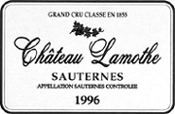
Classification: Second Growth in 1855
Owner: Guy Despujols
Address: 19, rue Principale, 33210 Sauternes
Telephone: 05 56 76 67 89; Telefax: 05 56 76 63 77
E-mail: guy.despujols@free.fr
Website: www.guy.despujols.free.fr
Visits: By appointment only
Contact: Guy Despujols
VINEYARDS
Surface area: 18.5 acres
Grape varietals: 85% Semillon, 10% Sauvignon, 5% Muscadelle
Average age of vines: 40 years
Density of plantation: 7,500 vines per hectare
Average yields: 18 hectoliters per hectare
Elevage: Fermentation in barrels. Twenty-six months aging (partly on lees) in barrels (with 75% new oak) for the Semillon and in vats (for the Sauvignon and Muscadelle). Fining and filtration.
WINES PRODUCED
Château Lamothe Despujols: 12,000 bottles
Les Tourelles de Lamothe: 3,000 bottles
Plateau of maturity: Within 3–12 years following the vintage
GENERAL APPRECIATION
This is an irregular performer.
Known in the 19th century as Lamothe-d’Assault, this property was partitioned, and there are now two Lamothe estates, both carrying the suffix of the current owner’s family name. Lamothe Despujols tends to make relatively light wines, but they are worth tasting since there have been some surprises (as in 1986). With the high percentage of Muscadelle in the blend, the style is one of fragrance and soft, forward fruit. I thought there was a noticeable increase in quality in the late 1980s.
IMPORTANT VINTAGES
2001 |
The 2001 reveals a moldy/mushroomy note in its unexpressive aromatics. I attempted to extrapolate what this wine might taste like without the mold, and it does appear to possess medium body, underlying minerality, and honeyed fruit, but it is straightforward and one-dimensional. Anticipated maturity: now–2012. Last tasted, 1/03. |
1996 |
A lean, light-styled Sauternes with tropical fruit notes in its medium-bodied personality, this is a pleasant, straightforward, good wine for picnics, etc. Drink it over the next 8–10 years. Last tasted, 3/00. |
The 1990 reveals an oily personality, big, ripe, honeyed fruit flavors, low acidity, plenty of intensity, and a full-bodied, chewy style that suggests it should be drunk over the next 10 years. Last tasted, 11/94. |
|
1989 |
The 1989 is displaying far greater richness, intensity, and cleanliness than previous examples revealed. It exhibited good fatness, an unctuous texture, low acidity, and lovely rich, intense, tropical fruit. It should drink well for 7–8 years. Last tasted, 11/94. |
1988 |
It is hard to understand what could have happened at Lamothe Despujols in such a superb vintage as 1988. This wine is dull, muted, and lacking fruit, freshness, and character. It performed this way in three separate tastings. Anticipated maturity: now. Last tasted, 4/91. |
1986 |
For as inconsistent and indifferent as Lamothe Despujols can be, the 1986 is irrefutably a sleeper of the vintage. A wonderful honeyed nose with a whiff of toasty oak is followed by an opulent, intense, rich, glycerin-filled, full-bodied, beautifully balanced Sauternes that should drink well for another 10–15 years. It is undoubtedly the best example I have ever tasted from this property. Anticipated maturity: now–2005. Last tasted, 3/90. |
1985 |
This big, fat, surprisingly rich and intense wine exhibits a great deal more weight and character than many other properties in this vintage. There is very little evidence of botrytis, but there are gobs of fruit in a relatively straightforward, chunky style. Anticipated maturity: now. Last tasted, 3/90. |
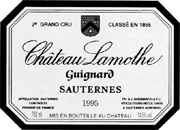
Classification: Second Growth in 1855
Owners: Philippe and Jacques Guignard
Address: 33210 Sauternes
Telephone: 05 56 76 60 28; Telefax: 05 56 76 69 05
Visits: Monday to Friday, 8 A.M.–noon and 2–6 P.M.
Contact: Philippe and Jacques Guignard
VINEYARDS
Surface area: 79 acres
Grape varietals: 90% Semillon, 5% Sauvignon, 5% Muscadelle
Average age of vines: 40 years
Density of plantation: 6,600 vines per hectare
Average yields: 17 hectoliters per hectare
Elevage: Fermentation in small vats. Twelve to fifteen months aging in barrels with 20–25% new oak. Fining and filtration.
WINES PRODUCED
Château Lamothe Guignard: 30,000 bottles
L’Ouest de Lamothe Guignard: 5,000 bottles
Plateau of maturity: Within 5–15 years of the vintage
An up-and-coming estate that merits a closer look.
The proprietors of Lamothe Guignard, Philippe and Jacques Guignard, purchased this property in 1981 and have set about in an aggressive manner to resurrect the image of Lamothe Guignard. This could be a property to keep a close eye on in the upcoming years, as the quality of the wines has been promising.
The vineyard is well located several miles to the south of Yquem, just off route D125. Sitting on a clay/gravel ridge, it overlooks the valley of the Ciron. Among the premiers crus classés, it is closest to Guiraud, La Tour Blanche, and Lafaurie-Peyraguey. The proprietors have increased the percentage of new oak and have begun making more passes through the vineyard to harvest only fully botrytised grapes. The results have been impressive and somewhat undervalued wines.
IMPORTANT VINTAGES
2001 |
Dense, full-bodied, very primary, but showing plenty of honeysuckle, candied citrus, and orange marmalade notes, this wine looks to be an outstanding effort. Anticipated maturity: 2005–2015. Last tasted, 1/03. |
2000 |
Deep golden, very fruity, somewhat simple, but lovely in a uncomplicated, lush style, drink this wine over the next 10 years. Last tasted, 1/03. |
1997 |
This wine reveals considerable botrytis, and a monolithic, fat, somewhat disjointed personality. It does offer currant, coconut, and honeyed fruit, and medium to full body, but no focal point or potential complexity. It needs more time to reveal its true identity. Anticipated maturity: now–2015. Last tasted, 3/01. |
1996 |
Less botrytis than the 1997 and a Sauvignon Blanc–dominated personality characterize the melony, herb-tinged, honeyed nose of this medium-weight wine. Relying on elegance, purity, and finesse as opposed to power and blockbuster strength, this medium-bodied Sauternes should be drinkable young, yet keep for another 12 years. Last tasted, 3/01. |
1990 |
The 1990 is a forceful, unctuous, thick, chewy Sauternes with plenty of heady alcohol, gobs of fruit, and an exuberant personality. It reveals greater aromatics, complexity, dimension, and delineation than it did several years ago. It should age well and evolve for 15–20 more years. Last tasted, 11/94. |
1989 |
The 1989 also displays more personality and complexity. Although it possesses very high alcohol (nearly 15%), it is a massive, highly extracted, extremely rich, impressively endowed wine that is oozing with honeyed, buttery, apricot, orange, pineapple, and lemony fruit. Noticeable acidity gives uplift and vibrance to this huge wine. Lamothe Guignard’s 1989 has turned out to be a sleeper of the vintage and should be available at a reasonable price. It should last for 20+ years. Last tasted, 11/94. |
1988 |
The backward, streamlined 1988 possesses a waxy, honeyed, Tokay-Pinot Gris–like fragrance and rich, full-bodied flavors that appear reticent and restrained because of the wine’s good acidity. A shy example of this estate’s wine, it is not nearly as ostentatious or muscular as the 1990 or 1989. It should last for 20–25 years. Last tasted, 11/94. |
1986 |
The 1986 Lamothe Guignard has a lovely moderately intense, pineapple fruitiness, rich, velvety flavors, plenty of botrytis, and a long, silky finish. While it will not be one of the longest-lived 1986s, it certainly is capable of providing immense satisfaction for another 5–7 years. Anticipated maturity: now. Last tasted, 3/90. |
Once again, the shortcomings of the 1985 Barsac/Sauternes vintage are obvious in this straightforward, relatively fat, but uninteresting and monolithically styled Sauternes. It is sweet, rich, full, and heavy, but there is a lack of grip as well as complexity. Anticipated maturity: now. Last tasted, 3/90. |
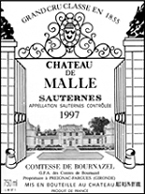
Classification: Second Growth in 1855 Classification
Owner: Comtesse de Bournazel
Address: 33210 Preignac
Telephone: 05 56 62 36 86; Telefax: 05 56 76 82 40
E-mail: chateaudemalle@wanadoo.fr
Website: www.chateau-de-mall.fr
Visits: Cellars: By appointment only; Château and gardens: April 1 to October 31 by appointment in the morning and 2–6 P.M.
VINEYARDS
Surface area: 66.7 acres
Grape varietals: 70% Semillon, 27% Sauvignon, 3% Muscadelle
Average age of vines: 30–40 years
Density of plantation: 6,200 vines per hectare
Average yields: 20 hectoliters per hectare
Elevage: Direct pressing and 10 hour cold settling. Fermentation and 18 months aging in barrels that are renewed by a third at each vintage. Fining and filtration.
WINES PRODUCED
Château de Malle: 50,000 bottles
Château de Sainte-Hélène: 25,000 bottles
Plateau of maturity: Within 5–15 years of the vintage
GENERAL APPRECIATION
In 2003, this is one of the most consistently excellent wines of the region.
This magnificent estate, with its extraordinary 17th-century château, was at one time owned by a member of the Lur Saluces family (the proprietors of Yquem and de Fargues). However, that ownership ended in 1785. Since then the property has been in the Bournazel family. De Malle is a vast estate, with over half its acreage in Graves. Those readers who have tasted the excellent white Graves made by Château de Malle, the M. de Malle, or their red wine, Château Cardaillan, know how serious those wines can be. I also recommend that visitors to the Barsac/Sauternes region go out of their way to get an appointment to visit Château de Malle, which was classified as a historic monument by the French government in 1949.
Even if you have no interest in architecture, the wines are worth tasting; they are among the most elegant of the appellation. At times they can have a tendency to turn out light, but recent vintages (from the more restrained and refined school of Sauternes) have been extremely well made.
IMPORTANT VINTAGES
2001 |
A superb Sauternes, de Malle’s moderately sweet wine has a light-gold color with some green tints. Honeyed citrus along with tropical fruits, peach, crème caramel, and smoked hazelnuts all jump from the glass of this layered, full-bodied, gorgeously pure and well-delineated wine. It is moderately sweet, but the good acidity and depth are impressive. Anticipated maturity: 2007–2020. Last tasted, 1/03. |
2000 |
A very seductive nose of honeysuckle and pineapples follow through in the flavors of this medium-to full-bodied, very unctuously textured, chunky but fleshy and appealing wine. Drink it over the next 10–15 years. Last tasted, 1/03. |
1999 |
Light gold in color, with a very spicy nose intermixed with some hints of apricot, white peach, and sweet corn, this wine is medium-bodied and fruit-driven, but somewhat short in the finish. Drink it over the next 7–10 years. Last tasted, 3/02. |
1997 |
An exotic, flamboyant bouquet of orange marmalade, honeyed citrus, caramel, coconut, and toast soars from the glass of this well-bodied, potentially outstanding effort. In the mouth, it reveals an unctuous texture with tangy underlying acidity, medium to full body, and gobs of fruit. Anticipated maturity: 2004–2020. Last tasted, 3/01. |
1996 |
This wine tastes high in acidity, with the Sauvignon Blanc more dominant (normally 75% of this wine is Semillon). It is medium bodied, slightly off dry as opposed to the sweeter, more viscous 1997, with evidence of pineapple and a clean, moderately long finish. Anticipated maturity: now–2016. Last tasted, 3/01. |
1990 |
Château de Malle’s 1990, the finest sweet wine the estate had made in decades, marks the resurrection of this château. Certainly it is an outstanding effort, and, given the reasonable price, it is a noteworthy purchase. The 1990 is full-bodied, with excellent sweetness, fine purity, and plenty of rich, honeyed fruit buttressed by noticeable new oak. It has not yet developed the complexity and aromatics displayed by the 1988, but the 1990 is clearly an outstanding effort for the vintage. Anticipated maturity: now–2022. Last tasted, 11/95. |
1989 |
The 1989 appeared to be somewhat simple. It is medium to full-bodied, with ripe, rich fruit, enough acidity to provide uplift, and a fleshy finish. It should drink well for another decade. Last tasted, 11/94. |
1988 |
The 1988 was “singing” at the top of its lungs in a recent tasting. Closer to maturity than the 1990, the 1988 offers a heavenly bouquet of cherries and coconuts as well as an ostentatious display of honeyed pineapples and toasty oak. Medium to full-bodied, with excellent purity, freshness, and ripeness, it is an ideal candidate for drinking or cellaring over the next 10–12 years. Last tasted, 11/94. |
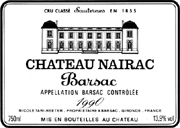
Classification: Second Growth in 1855
Owner: Nicole Tari-Heeter
Address: 33720 Barsac
Telephone: 05 56 27 16 16; Telefax: 05 56 27 26 50
Visits: By appointment only
Contact: Nicolas Heeter
Surface area: 42 acres
Grape varietals: 90% Semillon, 6% Sauvignon, 4% Muscadelle
Average age of vines: 40 years
Density of plantation: 8,000 vines per hectare
Average yields: 7 hectoliters per hectare
Elevage: Fermentations last one to three months in oak barrels, and wines are aged two and a half years before bottling (30–100% new oak). They are fined and filtered.
WINES PRODUCED
Château Nairac: 10,000 bottles
No second wine produced.
Plateau of maturity: Within 5–15 years of the vintage
GENERAL APPRECIATION
Corpulent, well-oaked, big, and bold wines characterize the style of this property.
Nairac is one of the most meticulously and passionately operated Barsac estates. In 1971 the property was purchased by American-born Tom Heeter and Nicole Tari. Heeter apprenticed at the red wine–producing property Giscours, in the Margaux appellation, where he met his wife (they are now divorced), a member of the Tari winemaking family. During the 1980s the celebrated Emile Peynaud was brought in to provide oenological advice, and Nairac began to produce some of the best wines of Barsac.
Nairac is a relatively big-styled, oaky, ripe, concentrated wine for a Barsac, but it is rarely exciting. However, it represents a good value and should be sought out by consumers looking for a good Barsac at a reasonable price.
IMPORTANT VINTAGES
1999 |
Deep medium gold–colored with a roasted/caramelized pineapple/apricot scent interwoven with oak, this medium-bodied wine possesses good sweetness, crisp acids, and an excellent finish. Anticipated maturity: 2007–2017. Last tasted, 1/02. |
1998 |
Light gold in color, with muted aromatics, this crisp, tangy, tight, somewhat earthy as well as oaky wine offers excellent purity, but largely uninspiring flavors. Will it improve? Anticipated maturity: 2004–2013. Last tasted, 1/02. |
1997 |
With 90% Semillon in the blend, in a year that favored this varietal, Nairac’s 1997 is an impressively endowed, full-bodied, intensely sweet wine with layers of flavor, considerable glycerin, a chewy, cherry liqueur–like, honeyed, smoky new oak–scented bouquet, and a long, intense, thick finish. It exhibits plenty of botrytis, seemingly low acidity, and the potential for an outstanding rating. Anticipated maturity: 2005–2020. Last tasted, 1/02. |
1990 |
Like many Nairacs, the 1990 is robust, solid, even corpulent, but it lacks great class as well as a focal point. Its medium deep-gold color is followed by aromas of burnt honey and apricots intermixed with vanilla beans and espresso. This sweet wine is fully mature. Anticipated maturity: now–2012. Last tasted, 1/02. |
When I first tasted the 1989 nairac from cask, it appeared to be excessively oaky as well as a bit too fat and alcoholic. However, it has evolved gracefully in the cask and now exhibits plenty of toasty vanilla-scented new oak, an opulently rich nose and texture, long, heady, unctuous flavors, and enough acidity for grip and focus. It will evolve quickly, as the color is already a deep-medium golden. Anticipated maturity: now. Last tasted, 4/91. |
|
1986 |
This is one of the finest Nairacs I have ever tasted. It is an especially rich, powerful, concentrated wine with gobs of glycerin-injected pineapple fruit, full body, and a long, luscious, smooth finish. There is plenty of acidity and evidence of botrytis, so I would expect a relatively long evolution for this top-class wine. Anticipated maturity: now–2010. Last tasted, 3/90. |
1985 |
The 1985 lacks botrytis, a problem that is typical of most wines of the 1985 vintage. Other than that, there is straightforward orange and pineapple fruit, heavily dosed with generous quantities of toasty new oak. Anticipated maturity: now. Last tasted, 3/89. |
1983 |
Extremely aromatic, the 1983 Nairac has a flowery, tropical fruit–scented bouquet, big, rich, fruit salad–like flavors, full body, and a luscious, honeyed finish. Anticipated maturity: now. Last tasted, 3/90. |
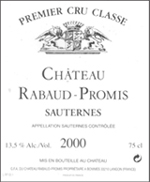
Classification: First Growth in 1855
Owner: GFA du Château Rabaud-Promis
Address: 33210 Bommes
Telephone: 05 56 76 67 38; Telefax: 05 56 76 63 10
Visits: By appointment only
Contact: Philippe Déjean
VINEYARDS
Surface area: 84 acres
Grape varietals: 80% Semillon, 18% Sauvignon, 2% Muscadelle
Average age of vines: 40 years
Density of plantation: 6,600 vines per hectare
Average yields: 14 hectoliters per hectare
Elevage: Three week fermentation and 12–14 months aging in barrels with 30% new oak. Fining, light filtration upon bottling.
WINES PRODUCED
Château Rabaud-Promis: 36,000 bottles
Château Béquet or Domaine de l’Estrémade: 24,000 bottles
Plateau of maturity: Within 5–20 years following the vintage
GENERAL APPRECIATION
This is an example of a Sauternes estate that is making better and better wines.
Rabaud-Promis was once part of a huge ancient domain called Rabaud. In 1903 Rabaud was divided into Rabaud-Promis and the more well-known Sigalas Rabaud. Curiously, the properties were reunited 26 years later, but then partitioned again in 1952.
Until 1986 Rabaud-Promis may have been the most disappointing wine among the premiers crus classés. However, no estate has made more progress in such a short period of time. Not only has a second wine been introduced, but the top wine now goes into small oak barrels, of which a healthy percentage is new each year. In the past, there was no selection, and the entire crop was matured in cement vats. Certainly the estate is beautifully situated on high ground at the junction of the Garonne and Ciron Rivers.
Shrewd connoisseurs of the sweet wines of Barsac/Sauternes should put such information to use, as it will probably take several years before the price catches up to the quality level now being exhibited. If the excellent examples of Rabaud-Promis that have emerged from the 2001, 1990, 1989, 1988, and 1986 vintages are typical of the new direction of this property, it will be one of the fuller-bodied, more luscious and intense Sauternes on the market.
IMPORTANT VINTAGES
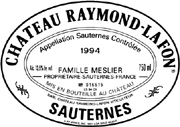
Classification: None
Owner: Meslier family
Address: 33210 Sauternes
Telephone: 05 56 63 21 02; Telefax: 05 56 63 19 58
Website: www.chateau-raymond-lafon.fr
Visits: By appointment only
Contact: Marie-Françoise Meslier
VINEYARDS
Surface area: 44.5 acres (39.5 in production)
Grape varietals: 80% Semillon, 20% Sauvignon
Average age of vines: 35 years
Density of plantation: 6,666 vines per hectare
Average yields: 10 hectoliters per hectare
Elevage: Fermentation and 36 months aging in new oak barrels. Fining, no filtration.
WINES PRODUCED
Château Raymond-Lafon: 20,000 bottles
Château Lafon-Laroze: variable
Plateau of maturity: Within 8–25 years following the vintage
GENERAL APPRECIATION
An impeccably run estate that produces top-flight wines, Raymond-Lafon has a connoisseur’s following, but quantities are small.
Raymond-Lafon is a name to watch in the Sauternes district, particularly if one is looking for a wine that is close to the brilliance and majestic richness of Yquem for less than one-third the price.
This small estate abuts Yquem’s vineyard and has had an excellent reputation. The 1921 Raymond-Lafon was considered even better than Yquem’s wine in that great vintage. I have never tasted the 1921 Raymond-Lafon, but the single greatest Sauternes I have ever drunk was the Yquem of that vintage. However, the estate of Raymond-Lafon fell into neglect, and it was not until 1972 that Pierre Meslier, the manager of Yquem, purchased this vineyard and began to slowly rebuild this wine’s once fabulous reputation.
With a tiny yield of nine hectoliters per hectare (even less than Yquem’s), with the same grape blend and winemaking techniques employed as Yquem, and with the same ruthless selection procedure (normally 20–100% of a harvest is declassified), Raymond-Lafon has already produced a succession of splendid Sauternes, beginning with a great 1975 and just recently concluding with a monumental 1990.
Raymond-Lafon looks to be well on the road to becoming one of the great classic wines of Sauternes. Unfortunately, the wine is extremely difficult to find because of the tiny production and the fact that proprietor Pierre Meslier sells much of it to private clients in Europe. One must wonder why this vineyard, situated next to Yquem and surrounded by all the premiers crus classés of Sauternes, was overlooked in the 1855 classification.
IMPORTANT VINTAGES
2001 |
A fabulous wine, with big, thick, massive, unctuous flavors, redolent with notes of peach, apricot, crème caramel, and espresso, this opulent, thick, full-bodied wine is very powerful, concentrated, and rich. It should drink well young yet last up to three decades. Anticipated maturity: 2008–2030. Last tasted, 1/03. |
1997 |
This light to medium gold–colored, fragrant, medium-to full-bodied, sweet wine is low in acidity, redolent with honeyed pineapple and pear notes intermixed with vanilla bean and crème brûlée. Luscious, rich, and evolved, it will drink well for 10–15 years. Anticipated maturity: now–2017. Last tasted, 11/02. |
1996 |
An outstanding wine, this light gold–colored, full-bodied wine exhibits honey-suckle, orange marmalade, and pineapple flavors intertwined with hints of vanilla and smoke. Rich, viscous, and deep, it is an impressive effort. Anticipated maturity: 2006–2022. Last tasted, 1/02. |
1990 |
The 1990 may be the most complete and richest of recent Raymond-Lafons. It possesses a light to medium gold color, with massive, full-bodied, honeyed flavors. Last tasted, 3/96. |
1989 |
The 1989 exhibits aromas of honeyed pineapple/tropical fruit and toasty new oak, as well as an exotic, flashy perfume that is not as pronounced in either the 1990 or 1988. The 1989 exhibits less botrytis than the other two vintages. All three wines share opulent, full-bodied, exotic, lavishly rich personalities, moderate sweetness (the 1990 is the sweetest), and huge quantities of extract, glycerin, and alcohol in their finishes. The 1990 appears to be the richest. Anticipated maturity: now–2025. Last tasted, 3/96. |
1988 |
The 1988 offers the most refined aromatic profile and the tightest structure, and the 1989 tastes the most restrained. This wine can be drunk now, but purchasers are advised to wait until 2005 or so to enjoy over the following two decades. Anticipated maturity: now–2020. Last tasted, 11/94. |
1987 |
Very light, with straightforward, fruity, slightly sweet flavors, this would make an attractive, but lowbrow apéritif wine. It does not have the requisite weight, sweetness, or complexity to stand by itself as a dessert wine. Anticipated maturity: now. Last tasted, 4/91. |
It is hard to believe this wine will eclipse the great 1983, but the differences in the two wines are negligible. I do not believe the 1986 makes quite the impact on the palate that the huge, massive 1983 does, but there is a great deal of botrytis and a profound, penetrating fragrance of sautéed pineapple, vanilla, toast, and honeyed peaches. In the mouth, the wine is more streamlined than the 1983, but lusciously rich and full-bodied, with very good acidity and a creamy, intense finish. It will be interesting to compare the 1986 and 1983 as they evolve. My guess is that the 1986 will age faster. Anticipated maturity: now–2012. Last tasted, 3/90. |
|
1985 |
This is one of the best 1985s I have tasted from Sauternes. It is rich and full, and although there is a general absence of any botrytis, the quality of the fruit is impeccably high. There is plenty of citrusy, pear, peach, and apricot-scented fruit backed up by some vague notes of roasted almonds. This is a delicious 1985 that should evolve gracefully. Anticipated maturity: now. Last tasted, 3/90. |
1983 |
This is a magnificent wine. Light golden, with a wonderfully pure tropical fruit aroma of ripe pineapples and melons, this decadently rich, full-bodied wine has layers of viscous, sweet fruit, an astonishing finish, and excellent balancing acidity. The wine remains stubbornly slow to evolve. Anticipated maturity: now–2020. Last tasted, 11/90. |
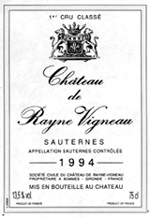
Classification: First Growth in 1855
Owner: SC du Château de Rayne Vigneau
Address: 33210 Bommes
Mailing address: Cordier—Mestrezat et Domaines, 109, rue Achard, BP 154, 33042 Bordeaux Cedex
Telephone: 05 56 11 29 00; Telefax: 05 56 11 29 41
E-mail: contact@cordier-wines.com
Visits: By appointment and for professionals of the wine trade only
VINEYARDS
Surface area: 207.5 acres
Grape varietals: 74% Semillon, 24% Sauvignon, 2% Muscadelle
Average age of vines: 30 years
Density of plantation: 6,000 vines per hectare
Average yields: 10–15 hectoliters per hectare
Elevage: Fermentation in barrels for part of the yield and in stainless-steel vats for the other. Eighteen to twenty-four months aging in barrels with 50% new oak. Fining and filtration.
WINES PRODUCED
Château de Rayne Vigneau: 36,000–100,000 bottles (depending upon the vintage)
Madame de Rayne: variable
Plateau of maturity: Within 5–20 years of the vintage
This estate would appear to have unlimited potential. However, the wines, while good, are largely unexciting.
During the 19th century, the beautiful Château de Rayne Vigneau had a reputation second only to that of Yquem. Few estates in the region are as superbly located as de Rayne Vigneau. However, because of neglect and indifferent winemaking, the 20th century has not been kind to the reputation of de Rayne Vigneau. Quality has improved significantly since the early 1980s, but there are still too many uninspiring efforts.
This vineyard has a splendid situation on the high plateau of Bommes on gravely/sandy soils. The wine now spends nearly 24 months in oak barrels, of which 50% are new each year. In the past, the percentage of new oak utilized was minimal, and one always suspected there was a lack of strict selection.
IMPORTANT VINTAGES
2001 |
The very light greenish-gold color stands out as one of the palest of the 2001 Barsac/Sauternes wines. This wine is delicate, somewhat light, but shows some attractive honeysuckle and citrus notes. It is medium bodied, not terribly intense, but very pleasant in a low-key sort of manner. Anticipated maturity: now–2014. Last tasted, 1/03. |
1999 |
Light gold, with straightforward notes of candied pineapple and spice box, this medium-bodied wine shows high acidity and a somewhat austere, emaciated style. Drink it over the next 5–10 years. Last tasted, 3/02. |
1997 |
Both the 1997 and 1996 de Rayne Vigneau are uninspiring, mainstream, blatantly commercial examples of Sauternes. The 1997 exhibits a syrupy pineapple-scented nose, medium body, moderate sweetness, and a fruit-driven personality with little complexity. Anticipated maturity: now–2017. Last tasted, 1/02. |
1996 |
More complex than the 1997, the 1996 reveals a honeyed melon and pineapple-scented nose, medium body, and fine purity and ripeness. Drink it over the next 10–12 years. Last tasted, 1/02. |
1990 |
This sweet, thick, juicy Sauternes does not possess as much complexity as the top wines of the vintage. Perhaps more will emerge with aging, as the wine is more sugary, cloying, and plump than previous examples from this estate. The color is light golden. This honeyed, buttery de Rayne Vigneau does not reveal as much precision, definition, or evidence of botrytis as exists in the vintage’s finest offerings. Nevertheless, there is plenty to enjoy in this straightforward, monolithic 1990. Anticipated maturity: now–2012. Last tasted, 3/97. |
1989 |
The 1989’s flowery, peach and honey nose and medium-to full-bodied, complex, finesse style is refreshing, yet has sweet, low acid. This commercially styled Sauternes is fully mature. Anticipated maturity: now–2006. Last tasted, 11/94. |
1988 |
The 1988 is the best example I have tasted from this property. An intense, honeyed, pear, flower, and apricot fragrance is reminiscent of Muscat de Beaumes de Venise. In the mouth, there is exceptional richness, super focus because of fine acidity, a wonderful touch of toasty new oak, and an elegant, very positive, crisp finish. This is a beautifully made, authoritative tasting, and impeccably well-balanced Sauternes. Anticipated maturity: now–2009. Last tasted, 3/90. |
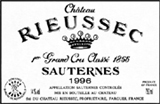
Classification: First Growth in 1855
Owner: Barons de Rothschild (Lafite)
Address: 33210 Fargues
Mailing address: Les Domaines Barons de Rothschild, 33, rue de la Baume, 75008 Paris
Telephone: 01 53 89 78 00; Telefax: 01 53 89 78 01
Website: www.lafite.com
Visits: By appointment only
Contact: Telefax: 05 57 98 14 10
VINEYARDS
Surface area: 185.3 acres
Grape varietals: 92% Semillon, 5% Sauvignon, 3% Muscadelle
Average age of vines: 25 years
Density of plantation: 7,500 vines per hectare
Average yields: 15 hectoliters per hectare
Elevage: Fermentation and 18–30 months aging in new oak barrels. Fining and filtration.
WINES PRODUCED
Château Rieussec: 60,000 bottles
Clos Labère: 60,000 bottles
Plateau of maturity: Within 6–25 years of the vintage
GENERAL APPRECIATION
Since its acquisition by Lafite Rothschild, Rieussec has become a legitimate superstar in the Sautemes.
As one approaches the heart of the Sauternes appellation, Château Rieussec and its prominent lookout tower can be spotted on one of the highest hillsides. The Rieussec vineyard, spread across the hillsides of Fargues and Sauternes overlooking the left bank of the Garonne, has the highest altitude after that of Yquem. Quite surprising for a Bordeaux property, the entire vineyard is one single unit, much of it bordering the hallowed Yquem.
Rieussec has always had an outstanding reputation, but after its acquisition by Albert Vuillier in 1971, the quality improved even more, largely because of the increase in new oak and more frequent passes through the vineyard to harvest only heavily botrytised grapes. In fact, some critics of Rieussec claimed that Vuillier’s wines took on too deep a color as they aged (like the 1976, for example). Vuillier sold Rieussec to the Domaines Barons de Rothschild, who have spared no expense or permitted any compromising in the making of Rieussec. The results have been truly profound offerings that are now routinely among the top three or four wines of the appellation. Wealthy collectors will no doubt argue for decades whether 2001, 1990, 1989, or 1988 produced the most profound Rieussec.
Rieussec’s style, one of honeyed power and almost roasted richness, exhibits great precision as well as tremendous persistence. The wine is usually deeply colored and generally alcoholic, with excellent viscosity. Rieussec also produces a dry white wine called “R.” Such wines help ease cash-flow problems considerably, and “R” is one of the most popular and best of the dry Sauternes.
IMPORTANT VINTAGES
ANCIENT VINTAGES
The 1976 (90 points; last tasted 1/01) is a controversial vintage for Rieussec. I still have a few bottles left in my cellar, and it is a huge wine, with over 15% alcohol, made from microscopic yields of 2.5 hectoliters per hectare. The color is very brown and deep, with a distinctive caramel flavor to the almost brown sugar and chocolaty fruit. There is some volatile acidity, but the wine is big, thick, juicy, and almost a hybrid cross between a Madeira and a Sauternes. Not everyone loves it, but I do. Anticipated maturity: now–2010. The 1975 (90 points; last tasted 1/01) shows good acidity, hints of caramel, and some notes of oxidation. The wine again comes across more like a hybrid between a Madeira and a Sauternes than what I consider a classic Sauternes, but the wine is impressive.
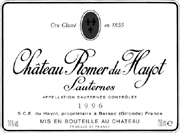
Classification: Second Growth in 1855
Owner: SCE Vignobles du Hayot
Address: 33720 Barsac
Telephone: 05 56 27 15 37; Telefax: 05 56 27 04 24
E-mail: vignoblesduhayot@ifrance.com
Visits: By appointment only
Contact: Fabienne du Hayot
VINEYARDS
Surface area: 37 acres
Grape varietals: 70% Semillon, 25% Sauvignon, 5% Muscadelle
Average age of vines: 35 years
Density of plantation: 6,500 vines per hectare
Average yields: 25 hectoliters per hectare
Elevage: Fermentation in temperature-controlled stainless-steel tanks. Eighteen months aging in barrels. Fining and filtration.
WINES PRODUCED
Château Romer du Hayot: 50,000 bottles
No second wine is produced.
Plateau of maturity: Within 3–15 years of the vintage
GENERAL APPRECIATION
This is an inexpensive, reliable wine that is well made but rarely exciting.
I have generally enjoyed the wines of Romer du Hayot, a small Sauternes estate located near the beautiful Château de Malle. The style of wine produced emphasizes a fresh fruity character, medium body, and moderate sweetness. The wine sees limited aging in barrels, so its exuberant fruitiness is not masked by spicy, oaky aromas and flavors.
While Romer du Hayot is a lighter-styled Sauternes, it has plenty of interest and generally ages well for 5–15 years. Fortunately, the price asked for the wines from this little-known property is reasonable.
1997 |
The 1997 possesses attractive pear liqueur, pineapple, and apricot fruit in its moderate aromatics, plenty of botrytis, and a sweet, long, unctuously textured, thick finish. However, the wine comes across as disjointed and in need of delineation. It should keep and evolve for 12 or more years. Last tasted, 1/02. |
1996 |
The 1996 is a classic, pure wine with well-integrated toasty oak, smoky, honeyed pineapple, mineral and fruit cocktail–like notes, a firm underpinning of acidity, round, smoky richness, medium to full body, and outstanding purity. Anticipated maturity: now–2015. Last tasted, 1/02. |
1990 |
The 1990 Romer du Hayot exhibits a moderately intense, pineapple-scented nose, medium-bodied, ripe, sweet flavors, and a clean, fresh finish. It is an uncomplicated, easygoing wine for drinking over the next 7–8 years. Last tasted, 11/94. |
1989 |
The 1989 revealed excessive sulphur in the nose, combined with a pronounced pungent, dirty earthiness in the mouth. Behind the annoying off components is a simple, medium-bodied, moderately sweet wine. Last tasted, 11/94. |
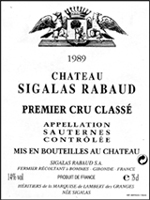
Classification: First Growth in 1855
Owner: GFA Château Sigalas Rabaud
Address: Bommes, 33210 Langon
Mailing address: Domaines Cordier, 53, rue du Dehez, 33290 Blanquefort
Telephone: 05 56 95 53 00; Telefax: 05 56 95 53 01
Visits: By appointment only
Contact: Marie-Stéphane Malbec
VINEYARDS
Surface area: 34.6 acres
Grape varietals: 85% Semillon, 15% Sauvignon
Average age of vines: 45 years
Density of plantation: 6,660 vines per hectare
Average yields: 18 hectoliters per hectare
Elevage: Fermentations take place in barrels at low temperatures (18°C). Wines are aged 20 months minimum in oak barrels that are renewed by a third in each vintage, with regular racking every three months. They are fined and filtered.
WINES PRODUCED
Château Sigalas Rabaud: 30,000 bottles
Le Cadet de Sigalas: 8,000 bottles
Plateau of maturity: Within 5–25 years of the vintages
GENERAL APPRECIATION
With the spectacular 2001, perhaps this well-situated estate is finally going to exploit its vast potential.
This has always been a perplexing wine to evaluate. There is no question that the ideal positioning of the south-facing vineyard on the hillsides of Haut-Bommes, with gravelly clay soil, should produce exceptionally ripe grapes. However, when tasting the wines of Sigalas Rabaud, I have always sensed a certain laissez-faire attitude. Since the mid-1980s the wines have improved significantly.
IMPORTANT VINTAGES
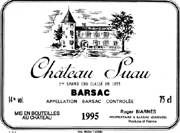
Classification: Second Growth in 1855
Owner: Nicole Biarnes
Address: 33720 Barsac
Mailing address: c/o Château de Navarro, 33720 Illats
Telephone: 05 56 27 20 27; Telefax: 05 56 27 26 53
Visits: By appointment Monday to Saturday
Contact: Mr. or Mrs. Biarnes
VINEYARDS
Surface area: 19.8 acres
Grape varietals: 80% Semillon, 10% Muscadelle, 10% Sauvignon
Average age of vines: 35 years
Density of plantation: 6,000 vines per hectare
Average yields: 18–19 hectoliters per hectare
Elevage: Eighteen months aging in barrels that are renewed by a third at each vintage. Fining and filtration.
WINES PRODUCED
Château Suau: 19,000 bottles
No second wine is produced.
Plateau of maturity: 5–12 years
GENERAL APPRECIATION
This is a reasonably priced, pleasant, straightforward wine for uncritical quaffing.
The tiny estate of Suau tucked away on a back road of Barsac is largely unknown. Much of the production is sold directly to consumers. The quality is uninspiring. In general, this is a wine to consume within its first decade of life.
IMPORTANT VINTAGES
1997 |
My first impression of the 1997 Suau’s aromas was reminiscent of apricots that had been macerating in cognac. There is not much finesse in the nose, but in the mouth this medium-to full-bodied, somewhat clumsy wine is rustic, pure, rich, and substantial with plenty of botrytis. Perhaps it just needs more time to find its form. Anticipated maturity: now–2012. Last tasted, 1/02. |
In contrast with the 1997, the 1996 is a lighter-styled, well-made Barsac with citrusy, white corn, apple, and white peach-like fruit. It is a moderately sweet, lightweight wine to enjoy over the next 7 years. Last tasted, 3/00. |
|
1990 |
1990 is the most opulent, concentrated, and powerful Suau I have ever tasted. Big and full-bodied, the wine now offers greater precision and complexity in its nose, an improvement over its original monolithic personality. A fine example of Suau, it should age well for 7–8 years. Last tasted, 11/94. |
1989 |
The 1989 exhibits elegance combined with medium body, which is atypical for this fat, heavyweight vintage. The wine possesses considerable finesse, a lovely apricot/pineapple-like fruitiness, and a crisp, fresh personality. It is not a wine for aging, but, rather, one for drinking over the next 5–7 years. Last tasted, 11/94. |
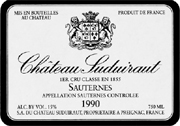
Classification: First Growth in 1855
Owner: AXA Millésimes
Administrator: Christian Seely
Address: 33210 Preignac
Telephone: 05 56 63 61 90; Telefax: 05 56 63 61 93
E-mail: infochato@suduiraut.com
Website: www.chateausuduiraut.com
Visits: By appointment only
VINEYARDS
Surface area: 222.3 acres
Grape varietals: 90% Semillon, 10% Sauvignon
Average age of vines: 25 years
Density of plantation: 7,000 vines per hectare
Average yields: 17 hectoliters per hectare
Elevage: Two to three week fermentation and 18 months aging in barrels with 30% new oak. Fining, no filtration.
WINES PRODUCED
Château Suduiraut: variable
Castelnau de Suduiraut: variable
Plateau of maturity: Within 8–30 years following the vintage
GENERAL APPRECIATION
Suduiraut is undeniably one of the great estates of Sauternes, and has been even more consistent as well as brilliant since its acquisition by AXA.
Just down the road from Yquem, abutting Yquem’s vineyards on the north, is the large, beautiful estate of Suduiraut. Suduiraut can be one of the great wines of Sauternes. For example, the 1990, 1989, 1988, 1982, 1976, 1967, and 1959 are staggering examples of Suduiraut’s potential. At its best, Suduiraut turns out very rich, luscious wines that in blind tastings can be confused with Yquem. However, I have always been perplexed by the shocking inconsistency in quality of the wines from this estate. In the first half of the 1970s, Suduiraut produced several wines well below acceptable standards, yet under the administration of AXA, the estate has fully exploited its immense potential.
When Suduiraut is good, it is very, very good. In great vintages, the wine needs a decade to be at its best, but will keep easily for 30 years. Richly colored, quite perfumed, and decadently rich, even massive in the top years, Suduiraut, while less consistent than properties like Climens and Rieussec, appears now to be back on track.
In 1989 and 1982 the château produced a sumptuous, super quality, rare, and expensive Crème de Tête—Cuvée Madame. This cuvée, much like the limited edition Cuvée Madame of Château Coutet, is capable of rivaling Yquem, but the production is minuscule—less than 1,000 cases.
IMPORTANT VINTAGES
ANCIENT VINTAGES
The 1976 (92 points; last tasted 3/90) is the finest Suduiraut of the 1970s. From the 1960s, the fabulous 1967 (93 points; last tasted 12/02) is fully mature. Ditto for the 1961 (92 points; last tasted 12/02). I have consistently rated the great 1959 between 92 and 94 on the occasions I have tasted it (most recently 12/89). Among the other vintages for which I have notes, I have given excellent ratings to the 1945 (90 points in 11/86) and the 1947 (93 points in 7/87). I have never seen a pre–World War II vintage, but the 1928 and 1899 are considered legendary years for this estate. The other years I have tasted, 1955 and 1949, left me unmoved.
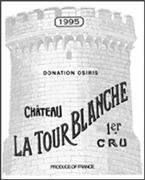
Classification: First Growth in 1855
Owner: Ministry of Agriculture
Address: 33210 Bommes
Telephone: 05 57 98 02 73; Telefax: 05 57 98 02 78
E-mail: tour-blanche@tour-blanche.com
Website: www.tour-blanche.com
Visits: Preferably by appointment Monday to Friday, 9 A.M. to noon and 2–5 P.M.
Contact: Corinne Reulet
VINEYARDS
Surface area: 91.4 acres
Grape varietals: 83% Semillon, 12% Sauvignon, 5% Muscadelle
Average age of vines: 26 years
Density of plantation: 6,200 vines per hectare
Average yields: 14 hectoliters per hectare
Elevage: Two to three week fermentation and 16–18 months aging in new oak barrels for the Semillon and in stainless-steel vats for Sauvignon and Muscadelle. Fining and filtration.
WINES PRODUCED
Château La Tour Blanche: 40,000 bottles
Les Charmilles de la Tour Blanche: 25,000 bottles
Plateau of maturity: Within 5–30 years following the vintage
GENERAL APPRECIATION
This estate has soared in quality since the late eighties, and is now one of the most consistent wines of the region.
La Tour Blanche was ranked in the top of its class right behind Yquem in the 1855 classification of the wines of the Sauternes region. Since 1910 the Ministry of Agriculture has run La Tour Blanche and until the mid-1980s seemed content to produce wines that at best could be called mediocre. That has changed significantly with the employment of 100% new oak beginning in 1988, followed by a complete fermentation of the 1989 in new oak barrels. The cellars are completely air-conditioned, and the yields have been reduced to a meager 14 hectoliters per hectare. All things considered, La Tour Blanche is now one of the superstars of the appellation. Fortunately, prices have not yet caught up with La Tour Blanche’s new quality.
There are also small quantities of a second wine made from weaker vats, as well as two different dry Bordeaux blancs.
2001 |
With a rather remarkable, almost strawberry aroma intermixed with ripe peach and pineapple, this beautifully balanced, full-bodied wine has great fruit presence, tremendous definition, large body, and, like so many 2001s, a remarkable vibrancy and zestiness because of good acidity. This is probably the best example from this estate since their sensational 1990. Anticipated maturity: 2007–2025+. Last tasted, 1/03. |
1999 |
This estate continues to come on stronger and stronger, seemingly regardless of vintage conditions. Light gold with a nose of tangerines intermixed with apricots and peach jam, with a hint of oak and acacia flower, this medium-to full-bodied, very concentrated wine has excellent sweetness, noticeable botrytis, some sweet oak, and enough acidity to frame everything up. It is not a blockbuster, but certainly very well made. Anticipated maturity: now–2018. Last tasted, 1/03. |
1998 |
A brilliant effort from this resurrected property, the 1998 La Tour Blanche has loads of sweet, concentrated honeysuckle, pineapple, and apricot-like fruit, great harmony, good integrated acidity, subtle wood, and a full-bodied, very opulent, flamboyant finish. This is a classic full-throttle Sauternes that can be drunk young or aged for two decades. Anticipated maturity: now–2022. Last tasted, 1/03. |
1997 |
The gorgeously perfumed and layered 1997 La Tour Blanche displays a medium-gold color, as well as a honeyed, kinky nose of buttered roasted fruit, quince, oranges, and minerals. Dense and full-bodied, with terrific fruit extraction, this unctuously textured, sweet wine is one of the stars of the vintage. Anticipated maturity: now–2025. Last tasted, 1/02. |
1996 |
The lighter-style 1996 possesses a light golden color, moderate sweetness, and a flinty, citrusy, buttery nose with evidence of coconut, pears, oranges, and pineapples. In the mouth, it is medium bodied and stylish with considerable elegance. Anticipated maturity: now–2015. Last tasted, 3/01. |
1990 |
A sensational effort, fragrant notes of honeysuckle, orange marmalade, pineapple, and lanolin jump from the glass of this full-bodied, very luxuriously sweet wine, which has tremendous purity and definition. It is a very seductive style that has already reached full maturity. Anticipated maturity: now–2020. Last tasted, 1/03. |
1989 |
Although loosely structured, the 1989 reveals plenty of intense, honeyed fruit in a rich, authoritative, full-bodied format. A big, powerhouse, sweet, heavy wine with a penetrating fragrance of honey and flowers, this generously endowed wine already drinks well but can easily last for 15–20 years. Last tasted, 11/94. |
1988 |
The 1988 exhibits superb richness, plenty of botrytis, creamy, honeyed, tropical fruit (pineapples galore), wonderfully integrated, toasty oak, crisp acidity, and a rich, full-bodied, long finish. The wine is just beginning to evolve, and it is clearly capable of lasting 25–35 years. Last tasted, 11/94. |
1986 |
When I tasted this wine from cask I thought it would be better. But it has turned out to be a relatively straightforward, compact, monolithic-styled Sauternes, with good fruit but without the great underlying depth and evidence of botrytis one normally sees in this vintage. It should provide good but uninspired drinking for another decade or more. Anticipated maturity: now. Last tasted, 3/90. |
1985 |
Normally the 1985 Sauternes are less impressive than the 1986s, but La Tour Blanche’s 1985 comes across as more concentrated, with greater intensity and length than the 1986. Nevertheless, there is still a glaring lack of complexity and botrytis. Anticipated maturity: now. Last tasted, 3/90. |
The finest older vintage of La Tour Blanche I have had the privilege of tasting was a very fine example of the 1975 (87 points in 1990). It was still youthful when tasted at age 15.
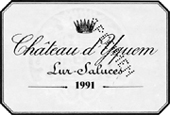
Classification: First Growth in 1855
Owner: SA du Château d’Yquem
Address: 33210 Sauternes
Telephone: 05 57 98 07 07; Telefax: 05 57 98 07 08
E-mail: v1@yquem.fr
Website: www.chateau-yquem.fr
Visits: By appointment and for professionals of the wine trade only
Contact: Valérie Lailheugue
VINEYARDS
Surface area: 308.8 acres (254.2 in production)
Grape varietals: 80% Semillon, 20% Sauvignon
Average age of vines: 30 years
Density of plantation: 6,500 vines per hectare
Average yields: 8 hectoliters per hectare
Elevage: Fermentation and 42 months aging in new oak barrels. Fining and filtration.
WINES PRODUCED
Château d’Yquem: 110,000 bottles
No second wine is produced.
Plateau of maturity: Within 10–100 years of the vintages
Note: This estate also produces a dry Bordeaux white called YGREC. It was made in the following vintages: 2000, 1996, 1994, 1998, 1985, 1980, 1979, 1978, 1977, 1973, 1972, 1971, 1969, 1968, 1966, 1965, 1964, 1962, 1960, 1959
D’Yquem was not produced in 1992, 1974, 1972, 1964, 1952, 1951, 1930, 1915, 1910
GENERAL APPRECIATION
A persuasive case can be made that Yquem is Bordeaux’s single greatest wine.
Yquem, located in the heart of the Sauternes region, sits magnificently atop a small hill overlooking the surrounding vineyards of many of the premiers crus classés. Between 1785 and 1997 this estate was in the hands of just one family. Comte Alexandre de Lur Saluces is the most recent member of this family to have responsibility for managing this vast estate, having taken over for his uncle in 1968. In 1997 the estate was sold to the giant Moët-Hennessy conglomerate, but the sale was unsuccessfully contested by Comte de Lur Saluces, who has remained as administrator.
Yquem’s greatness and uniqueness are certainly a result of a number of factors. First, it has a perfect location that is said to have its own microclimate. Second, the Lur Saluces family installed an elaborate drainage system with over 60 miles of pipes. Third, there is a fanatical obsession at Yquem to produce only the finest wines regardless of financial loss or trouble. It is this last factor that is the biggest reason why Yquem is so superior to its neighbors.
At Yquem they proudly boast that only one glass of wine per vine is produced. The grapes are picked at perfect maturity one by one by a group of 150 pickers who frequently spend six to eight weeks at Yquem and go through the vineyard a minimum of four separate times. In 1964 they canvassed the vineyard 13 separate times, only to have harvested grapes that were deemed unsuitable, leaving Yquem with no production whatsoever in that vintage. Few winemaking estates are willing or financially able to declassify the entire crop.
Yquem has unbelievable aging possibilities. Because it is so rich, opulent, and sweet, much is drunk before it ever reaches its tenth birthday. However, Yquem almost always needs 15–20 years to show best, and the great vintages will be fresh and decadently rich for as long as 50–75 or more years. The greatest Yquem I ever drank was the 1921. It was remarkably fresh and alive, with a luxuriousness and richness I shall never forget.
This passionate commitment to quality does not stop in the vineyard. The wine is aged for over three years in new oak casks, at a loss of 20% of the total crop volume due to evaporation. Even when the Comte de Lur Saluces deems the wine ready for bottling, a severe selection of only the best casks is made. In excellent years, such as 1980, 1976, and 1975, 20% of the barrels were eliminated. In difficult years, such as 1979, 60% of the wine was declassified, and in the troublesome vintage of 1978, 85% of the wine was declared unworthy of being sold as Yquem. To my knowledge, no other property has such a ruthless selection process. Yquem is never filtered for fear of removing some of the richness.
Yquem also produces a dry wine called “Y.” It is a distinctive wine, with a bouquet not unlike that of Yquem, but oaky and dry to taste and usually very full-bodied and noticeably alcoholic. It is a powerful wine and, to my palate, best served with a rich food such as foie gras. Yquem, unlike other famous Bordeaux wines, is not sold en primeur or as a wine future. The wine is usually released four years after the vintage at a very high price, but given the labor involved, the risk, and the brutal selection process, it is one of the few luxury-priced wines that merits a stratospheric price tag.
IMPORTANT VINTAGES
ANCIENT VINTAGES
It is remarkable tasting 25- to 50-year-old Yquems that are still relatively young in their evolution. In the 1970s, two perfect Yquems, based on recent tastings, are very different in style. The 1976 (100 points; last tasted 12/02) is an Yquem on a relatively fast track for this property. It seems to be close to full maturity, and remains a very powerful, thick, viscous Yquem with notes of honeyed tropical fruits, spice box, crème brûlée, smoke, and orange marmalade. The wine is viscous, rich, and an amazingly great Yquem. Among the vintages of the last 30 years, this is perhaps the most complex and ready to drink of the great years for Yquem. It should continue to evolve and last for another 50 or more years. Another perfect Yquem, the 1975 (100 points; last tasted 12/02) could not be more different. Evolving at a snail’s pace, this Yquem has always reminded me of some of the legends of the 20th century, the 1937 and 1921, for example. The wine still has a relatively light-gold color, a restrained but fascinating bouquet of smoke, honeyed peaches, pineapple, apricots, and hazelnuts intermixed with the telltale orange marmalade, coconut, and crème brûlée notes. A wine of extraordinary power but also remarkable finesse, it builds incrementally in the mouth, and just goes on and on in the finish, with a persistence that I once timed to be almost two minutes. It is a tour de force in winemaking and one of the all-time great Yquems. Believe it or not, it still needs another 10–20 years to reach maturity. Anticipated maturity: 2015–2075.
The 1971 (91 points; last tasted 6/98) and 1970 (90? points; last tasted 12/02) are both top-flight efforts, but hardly compelling examples of Yquem. A prodigious Yquem, of course, is the 1967 (96 points; last tasted 6/98). Other vintages in the 1960s are less impressive, although the 1962 (92 points; last tasted 3/02) can be outstanding. The 1961 (84 points; last tasted 4/82) is largely a disappointment.
There is no doubt that the two most profound and mature Yquems made in the 20th century were the 1921 (rated 100 points on two separate occasions, most recently 9/96) and the 1937 (rated between 96 and 99 points on three separate occasions in the late 1980s). After those two vintages, there are a number of superb Yquems that I have had the good fortune to taste, but frankly, none have matched the 1937 and 1921. My favorites in order of preference are 1928 (97 points in 4/91), 1929 (97 points in 3/90), 1959 (between 94 and 96 points on three occasions in the late 1980s), and 1945 (91 points in 10/95). The 1945 is, by all responsible accounts, a magnificent wine. However, the bottle I tasted in October 1995 was brown and slightly maderized, although well perfumed, but drying out. With any tasting of a wine over 20 years of age, it should be remembered that “there are no great wines, only great bottles.” Although I have only tasted the 1947 once (that is my birth year), I was surprised by how dry the wine tasted, without the fat and sweetness one finds in the great vintages of Yquem.
With respect to vintages from the 19th century, I had the good fortune to taste four 19th-century vintages at a tasting in October 1995. The 1825 Yquem (89 points) displayed a dark gold color and tasted nearly dry after having lost its fruit. It revealed high acidity in its crème brûlée-like flavors and finish. The very dry, earthy 1814 Yquem (67 points) possessed a dark-gold color and an unattractive mustiness that obliterated any fruit that may have remained intact. However, the 1811 Yquem (100 points), with its dark-gold color, awesomely intense, sweet nose, unctuous, thick, fabulous flavor extraction, pinpoint precision, and a finish that lasted a minute or more, is the kind of wine on which Yquem’s reputation is based. It was liquified crème brûlée—an astonishing wine. Remember, this was the famous “year of the comet” vintage. (Incidentally, readers looking for a few good chuckles should rent the movie video Year of the Comet, a wine-dominated comedy that I highly recommend.) The 1847 Yquem (100 points) would have received more than 100 points if possible. The wine is massive, with a surprisingly youthful color, remarkable honeyed and botrytised flavors, staggering richness, and a finish that lasted 40+ seconds. The question that must be asked is whether the great modern-day Yquem vintages will last as long? I say yes, though I doubt any of my readers will live long enough to find out what the 1990, 1989, 1986, 1983, 1976 or 1975 will taste like at age 148!
OTHER BARSAC/SAUTERNES ESTATES
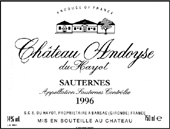
Classification: None
Owner: SCE Vignobles du Hayot
Address: 33720 Barsac
Telephone: 05 56 27 15 37; Telefax: 05 56 27 04 24
E-mail: vignoblesduhayot@ifrance.com
Visits: By appointment
Contact: Fabienne du Hayot
VINEYARDS
Surface area: 49.4 acres
Grape varietals: 70% Semillon, 25% Sauvignon, 5% Muscadelle
Average age of vines: 35 years
Density of plantation: 6,500 vines per hectare
Average yields: 25 hectoliters per hectare
Elevage: Fermentation in temperature-controlled stainless-steel tanks. Eighteen months aging in barrels (with 33% new oak) for part of the yield and in vats for the other. Fining and filtration.
Château Andoyse du Hayot: 65,000 bottles
No second wine is produced.
Plateau of maturity: Within 3–10 years of the vintage
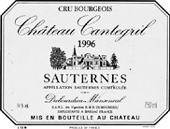
Classification: None
Owner: Denis Dubourdieu and Jeanine Dubourdieu
Address: 33720 Barsac
Mailing address: c/o Château Doisy-Daëne, 33720 Barsac
Telephone: 05 56 27 15 84; Telefax: 05 56 27 18 99
E-mail: reynon@gofornet.com
Visits: By appointment only; Monday to Saturday
Contact: Denis Dubourdieu (Telephone: 05 56 62 96 51; Telefax: 05 56 62 14 89)
VINEYARDS
Surface area: 54.3 acres
Grape varietals: 75% Semillon, 25% Sauvignon
Average age of vines: 30 years
Density of plantation: 6,250 vines per hectare
Average yields: 20 hectoliters per hectare
Elevage: Slow pressings. Fermentation and 12 months aging in barrels with 20% new oak. Fining and filtration.
WINES PRODUCED
Château Cantegril: 40,000 bottles
No second wine is produced.
Plateau of maturity: Within 4–8 years of the vintage
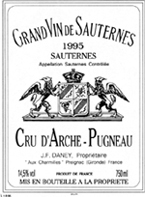
Owner: Jean-Francis Daney
Address: 24, Le Biton, Boutoc, 33210 Preignac
Telephone: 05 56 63 50 55; Telefax: 05 56 63 39 69
E-mail: francis.daney@free.fr
Website: www.arche.pugneau@free.fr
Visits: Monday to Friday, 8 A.M.–7 P.M.; by appointment on weekends
Contact: Jean-Francis Daney
Surface area: 32.1 acres
Grape varietals: 75% Semillon, 20% Sauvignon, 5% Muscadelle
Average age of vines: 40 years
Density of plantation: 7,500 vines per hectare
Average yields: 16 hectoliters per hectare
Elevage: Eight day fermentation in barrels followed by 3–4 weeks in vats. Twenty-four months aging in barrels. Fining and filtration.
WINES PRODUCED
Cru d’Arche-Pugneau: 8,000 bottles
Peyraguey Le Rousset: 3,000 bottles
Plateau of maturity: Within 5–20 years of the vintage
This property is well-worth searching out, as the wines are exceptionally well made and clearly compete with the top classified growths of Barsac/Sauternes. I have had remarkable wines from Cru d’Arche-Pugneau, which I rated in the mid-90s, particularly vintages such as 1990, 1989, and 1988. Even the 1991 was an amazing wine. Readers should look for the limited cuvée called Cru d’Arche-Pugneau Trie Exceptionnelle, a wine that can approach Yquem and Coutet Cuvée Madame–like richness and intensity. This is a virtually unknown estate that makes terrific wines.
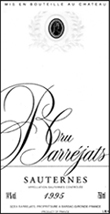
Classification: None
Owner: Mireille Daret and Philippe Andurand
Address: Clos de Gensac, Mareuil, 33210 Pujols-sur-Ciron
Telephone and telefax: 05 56 76 69 06
Visits: By appointment only
Contact: Mireille Daret
VINEYARDS
Surface area: 6.7 acres
Grape varietals: 85% Semillon, 10% Sauvignon, 5% Muscadelle
Average age of vines: 40 years
Density of plantation: 6,600 vines per hectare
Average yields: 16 hectoliters per hectare
Elevage: Fermentations take place in new oak barrels in which wines are aged for 18–36 months. Fining and filtration.
WINES PRODUCED
Cru Barréjats: 2,400–3,600 bottles
Accabailles de Barréjats: 1,200–3,000 bottles
Plateau of maturity: Within 3–8 years of the vintage
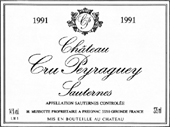
Classification: None
Owner: GFA Musotte
Address: 10 Miselle, 33210 Preignac
Telephone: 05 56 44 43 48; Telefax: 05 56 44 43 48
Visits: By appointment only
VINEYARDS
Surface area: 20.3 acres
Grape varietals: 75% Semillon, 25% Sauvignon
Average age of vines: 20 years
Density of plantation: 6,600 vines per hectare
Average yields: 20 hectoliters per hectare
Elevage: Fermentation and 12 months aging in barrels with 25% new oak. Wines then sojourn in vats before bottling. No fining, filtration.
WINES PRODUCED
Château Cru Peyraguey: 10,000 bottles
No second wine is produced.
Plateau of maturity: Within 3–8 years of the vintage
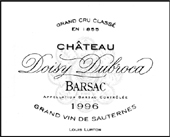
Classification: Second Growth in 1855
Owner: Louis Lurton
Address: 33720 Barsac
Mailing address: c/o Château Haut-Nouchet, 33650 Martillac
Telephone: 05 56 72 69 74; Telefax: 05 56 72 56 11
Website: www.louis-lurton.fr
No visits
VINEYARDS
Surface area: 8.1 acres
Grape varietals: 100% Semillon
Average age of vines: 20 years
Density of plantation: 6,600 vines per hectare
Average yields: 17 hectoliters per hectare
Elevage: Fermentation and 18 months aging in oak barrels (with 33% new oak) including six months élevage on fine lees. Fining and filtration.
Château Doisy Dubroca: 6,000 bottles
La Demoiselle de Doisy: 3,000 bottles
Plateau of maturity: Within 7–20 years of the vintage
Note: The vineyards of Château Doisy Dubroca are organically farmed and the wines produced are entitled to the Ecocert label.
GENERAL APPRECIATION
Although very difficult to find, this can be an undiscovered treasure of the region.
While I have tasted only a handful of recent vintages of Doisy Dubroca, this wine has an uncanny resemblance to the Barsac estate of Climens. In fact, for years the vinification and aging of the wines has been controlled by the same team that makes the wine at Climens.
As great as this wine has tasted in vintages such as 1989, 1988, and 1986, it has remained a fabulous value, largely because so little of it is made and most consumers know little about this château. It remains very much an insider’s wine to buy.
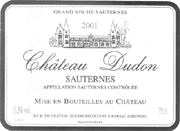
Classification: Cru Bourgeois
Owner: Evelyne and Michel Allien
Address: 1, Dudon, 33720 Barsac
Telephone: 05 56 27 29 38; Telefax: 05 56 27 29 38
E-mail: chateau.dudon.barsac@wanadoo.fr
Visits: Preferably by appointment
Contact: L. Bernard
VINEYARDS
Surface area: 29.1 acres
Grape varietals: 92% Semillon, 8% Sauvignon
Average age of vines: 28 years
Density of plantation: 6,600 vines per hectare
Average yields: 22 hectoliters per hectare
Elevage: Fermentation and 18 months aging in barrels with 25% new oak. Fining and filtration.
WINES PRODUCED
Château Dudon: 14,000 bottles
Château Gallien: 6,000 bottles
Plateau of maturity: Within 2–6 years of the vintage
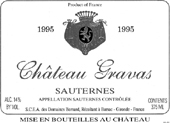
Classification: Cru Bourgeois
Owner: M. Bernard
Address: 33720 Barsac
Telephone: 05 56 27 06 91; Telefax: 05 56 27 29 83
Visits: Preferably by appointment, Monday to Friday, 9 A.M.–noon and 2–7 P.M.
Contact: M. Bernard
VINEYARDS
Surface area: 27.2 acres
Grape varietals: 80% Semillon, 10% Muscadelle, 10% Sauvignon
Average age of vines: 35 years
Density of plantation: 7,000 vines per hectare
Average yields: 23 hectoliters per hectare
Elevage: Four months fermentation in vats. Eighteen months aging by rotation in vats and barrels. Fining and filtration.
WINES PRODUCED
Château Gravas: 20,000 bottles
Château Simon Carretey: 13,000 bottles
Plateau of maturity: Within 2–6 years of the vintage
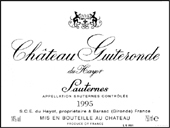
Classification: None
Owner: SCE Vignobles du Hayot
Address: 33720 Barsac
Telephone: 05 56 27 15 37; Telefax: 05 56 27 04 34
E-mail: vignoblesduhayot@ifrance.com
Visits: By appointment
Contact: Fabienne du Hayot
VINEYARDS
Surface area: 86.5 acres
Grape varietals: 60% Semillon, 30% Sauvignon, 10% Muscadelle
Average age of vines: 35 years
Density of plantation: 6,500 vines per hectare
Average yields: 25 hectoliters per hectare
Elevage: Fermentation in temperature-controlled stainless-steel tanks. Eighteen months aging in barrels (with 33% new oak) for part of the yield and in vats for the other. Fining and filtration.
Château Guiteronde du Hayot: 100,000 bottles
No second wine is produced.
Plateau of maturity: Within 3–10 years of the vintage
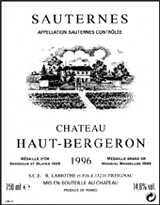
Classification: None
Owner: Lamothe family
Address: 33210 Preignac
Telephone: 05 56 63 24 76; telefax: 05 56 63 23 31
E-mail: haut-bergeron@wanadoo.fr
Visits: By appointment Monday to Friday, 9 A.M.–noon and 2–7 P.M.
Contact: Hervé or Patrick Lamothe
VINEYARDS
Surface area: 63 acres
Grape varietals: 90% Semillon, 8% Sauvignon, 2% Muscadelle
Average age of vines: 55 years
Density of plantation: 7,500 vines per hectare
Average yields: 20 hectoliters per hectare
Elevage: Fermentation in temperature-controlled stainless-steel vats. Fourteen to twenty months aging in barrels with 50% new oak. Fining depending upon the vintage, light filtration upon bottling.
WINES PRODUCED
Château Haut-Bergeron: 31,000 bottles
Château Fontebride: 25,000 bottles
Plateau of maturity: Within 3–8 years of the vintage
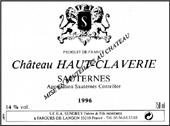
Classification: Cru Bourgeois
Owner: GFA du Domaine de Haut-Claverie
Address: Les Claveries, 33210 Fargues-de-Langon
Telephone: 05 56 63 43 09 or 06 81 28 90 02; Telefax: 05 56 63 51 16
Visits: Preferably by appointment, every day from 8 A.M. to 5 P.M.
Contact: Philippe Sendrey
Surface area: 32.1 acres
Grape varietals: 80% Semillon, 20% Sauvignon
Average age of vines: 35 years
Density of plantation: 5,800 vines per hectare
Average yields: 23 hectoliters per hectare
Elevage: Fermentation in stainless steel vats. Six to twelve months aging in barrels (no new oak) and 12–18 months aging in concrete vats. Fining and filtration.
WINES PRODUCED
Château Haut-Claverie: 17,000 bottles
No second wine is produced.
Plateau of maturity: Within 5 to 15 years of the vintage
Note: This estate also produces some 17,000–20,000 bottles of red Graves Château La Mourasse annually.
This obscure yet excellent property is located just south of the village of Fargues. The wine continues to sell at bargain basement prices. The secret here is not only an excellent microclimate, but late harvesting, several passes through the vineyard, and one of the most conscientious owners in the entire appellation.
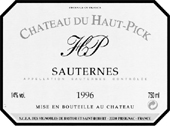
Classification: None
Owner: Foncier Vignobles
Address: Domaine de Lamontagne, 33210 Preignac
Telephone: 05 56 63 27 66; Telefax: 05 56 76 87 03
E-mail: bastor-lamontagne@dial.oleane.com
Website: www.atinternet.fr/bastor-lamontagne
No visits
VINEYARDS
Surface area: 22.2 acres
Grape varietals: 100% Semillon
Average age of vines: 35 years
Density of plantation: 7,000 vines per hectare
Average yields: 22 hectoliters per hectare
Elevage: Twenty-one day fermentation in vats. Twelve months aging by rotation in vats and in barrels (for 25% of the yield). No fining, filtration.
Château du Haut-Pick: 25,000 bottles
No second wine is produced.
Plateau of maturity: Within 5–10 years of the vintage
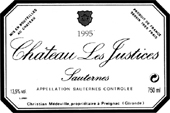
Classification: Cru Bourgeois
Owner: Christian Médeville
Address: 33210 Preignac
Mailing address: BP 14, 33210 Preignac
Telephone: 05 56 76 28 44; Telefax: 05 56 76 28 43
E-mail: christian.medeville@wanadoo.fr
Visits: By appointment Monday to Thursday, 9 A.M.–noon and 2–5 P.M.; Friday, 9 A.M. to noon and 2–3 P.M.
Contact: Julie Gonet-Médeville
VINEYARDS
Surface area: 21 acres
Grape varietals: 90% Semillon, 8% Sauvignon, 2% Muscadelle
Average age of vines: 35 years
Density of plantation: 6,600 vines per hectare
Average yields: 17 hectoliters per hectare
Elevage: Fermentation in temperature-controlled stainless-steel vats. Twelve to eighteen months aging in barrels that are renewed by a third at each vintage. Fining and filtration.
WINES PRODUCED
Château Les Justices: 19,000 bottles
No second wine is produced.
Plateau of maturity: Within 5–14 years of the vintage
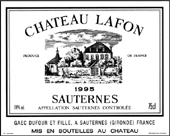
Classification: None
Owner: Olivier Fauthoux
Address: 33210 Sauternes
Telephone: 05 56 63 30 82; Telefax: 05 56 63 30 82
Visits: By appointment only
Contact: Olivier Fauthoux
VINEYARDS
Surface area: 29.6 acres
Grape varietals: 95% Semillon, 5% Sauvignon
Average age of vines: 35 years
Density of plantation: 6,000 vines per hectare
Average yields: 22 hectoliters per hectare
Elevage: Fermentation in temperature-controlled stainless-steel vats. Ten months aging in one-year-old barrels. No fining, filtration.
WINES PRODUCED
Château Lafon: 5,000 bottles
No second wine is produced.
Plateau of maturity: Within 3–8 years of the vintage
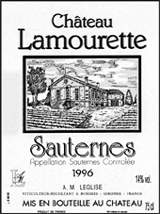
Classification: Cru Bourgeois
Owner: Anne-Marie Léglise
Address: 33210 Bommes
Telephone: 05 56 76 63 58; Telefax: 05 56 76 60 85
Visits: By appointment only
Contact: Anne-Marie Léglise
VINEYARDS
Surface area: 22.2 acres
Grape varietals: 90% Semillon, 5% Sauvignon, 5% Muscadelle
Average age of vines: 25 years
Density of plantation: 6,500 vines per hectare
Average yields: 25 hectoliters per hectare
Elevage: Twenty-one day fermentation in temperature-controlled stainless-steel vats. Wines are aged for 18 months in stainless-steel vats and in concrete vats. Fining and filtration.
WINES PRODUCED
Château Lamourette: 15,000 bottles
Château Cazenave: 7,000 bottles
Plateau of maturity: Within 3–8 years of the vintage
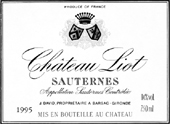
Classification: None
Owner: Jean-Gérard David
Address: 33720 Barsac
Telephone: 05 56 27 15 31; Telefax: 05 56 27 14 42
E-mail: château.liot@wanadoo.fr
Website: www.chateauliot.com
Visits: By appointment Monday to Friday, 9 A.M.–noon and 2–5 P.M.
Contact: Jean-Gérard David
VINEYARDS
Surface area: 49.4 acres
Grape varietals: 85% Semillon, 10% Sauvignon, 5% Muscadelle
Average age of vines: 35 years
Density of plantation: 7,500 vines per hectare
Average yields: 22 hectoliters per hectare
Elevage: Twenty to twenty-five day fermentation in barrels and vats. Eighteen months aging by rotation in barrels (with 20% new oak) for 60% of the yield and in vats for the rest. Fining and filtration.
WINES PRODUCED
Château Liot: 37,000 bottles
Château du Levan: 16,000 bottles
Plateau of maturity: Within 2–8 years of the vintage
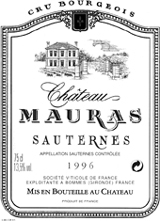
Classification: Cru Bourgeois
Owner: Société Vinicole de France
Address: 33210 Sauternes
Mailing address: Château Grava, 33350 Haux
Telephone: 05 56 67 23 89; Telefax: 05 56 67 08 38
Visits: By appointment only
Contact: Patrick Duale
VINEYARDS
Surface area: 37 acres
Grape varietals: 67% Semillon, 30% Sauvignon, 3% Muscadelle
Average age of vines: 25–30 years
Density of plantation: 6,000 vines per hectare
Average yields: 20–25 hectoliters per hectare
WINES PRODUCED
Château Mauras: 45,000 bottles
Clos du Ciron: 40,000 bottles
Plateau of maturity: Within 3–8 years of the vintage
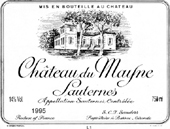
Classification: None
Owner: Sanders family
Address: 33720 Barsac
Telephone: 05 56 27 16 07; Telefax: 05 56 27 16 02
Visits: Monday to Friday, during working hours
Contact: Jean Sanders (Telephone: 05 56 63 19 54)
VINEYARDS
Surface area: 19.8 acres
Grape varietals: 60% Semillon, 40% Sauvignon
Average age of vines: Over 30 years
Density of plantation: 7,800 vines per hectare
Average yields: 17 hectoliters per hectare
Elevage: Fermentations take place in vats, and wines are transferred to oak barrels, 20% of which are new, for 12 months aging. They are fined but remain unfiltered.
WINES PRODUCED
Château du Mayne: 19,000 bottles
No second wine is produced.
Plateau of maturity: Within 3–8 years of the vintage
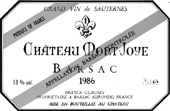
Classification: None
Owners: Frank and Marguerite Glaunès
Address: Quartier Miaille, 33720 Barsac
Mailing address: Domaine du Pas Saint-Georges, 33190 Casseuil
Telephone: 05 56 71 12 73; Telefax: 05 56 71 12 41
Visits: By appointment only
Contacts: Frank and Marguerite Glaunès
VINEYARDS
Surface area: 32.1 acres
Grape varietals: 75% Semillon, 15% Sauvignon, 10% Muscadelle
Average age of vines: 35 years
Density of plantation: 6,600 vines per hectare
Average yields: 20 hectoliters per hectare
Elevage: Regular cuvée: Fermentations take place partly in oak barrels and partly in lined vats. They are aged 24 months by rotation in vats and new oak barrels and are fined and filtered.
Cuvée spéciale: Fermentations last approximately 18 days in barrels, 30% of which are new, and wines are aged 20–24 months. They are fined and filtered.
WINES PRODUCED
Château Mont-Joye: 12,000 bottles
Château Jacques-le-Haut (cuvée spéciale): 5,000–10,000 bottles
Plateau of maturity: Within 4–10 years of the vintage